#so it's both fitting and subverted here
Explore tagged Tumblr posts
Text
Aziraphale's Ring Is a Queer Symbol
In a previous post I hold forth about the symbolism of the lion rampant on the escutcheon of Aziraphale's signet ring. The upshot is that the golden lion is used by Heaven as a symbol of its threat and its merciless, murderous corporate culture, and I argue that in S3 Aziraphale must subvert this stamp of Heavenly ownership and symbolically redefine the golden lion by summoning the courage to be soft.
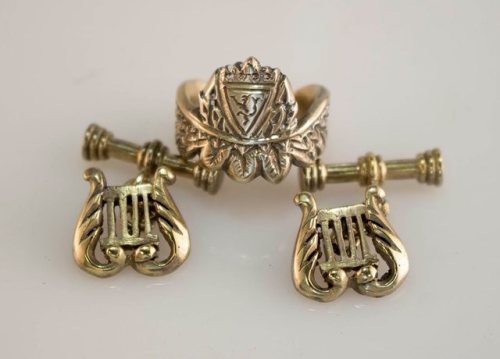
Now I've learned some new stuff about how signet rings are worn. Come, sistren, and get nerdy with me.
Aziraphale's ring is one of several we see angels wearing in Good Omens. Here in an indispensably useful post, @indigovigilance lists the known rings of Show Omens angels and those rings' qualities and placement. Note how of the angels who have rings, everyone except Saraqael and Aziraphale wear their rings on their LEFT pinky fingers. There's a reason for this.
Since the medieval period in Britain and Germany, and from there in the U.S., signet rings have been bestowed by professional associations as a sign of membership, particularly at the upper end of society: trade guilds, colleges, hospitals, the Church(es), noble families, and societies like the Freemasons all issue(d) signet rings to some of their members. The traditional placement for signet rings of show professional affiliation is the left pinky finger.
In fact, as it was not socially acceptable in or past the Victorian era for men to wear rings on more than one finger, men who wore signet rings and wedding rings both would have their wedding rings sized to fit the pinky finger below the signet. If a ring had to be moved to preserve masculinity, it wasn't the pinky ring that was going anywhere. Family signets can be worn on any of a number of fingers, but since the Victorian period the men of the British Royal Family (who are from Germany) have been especial sticklers about wearing their signets on their left pinky fingers as well.
So. If you're British and you have a signet ring that's meant to indicate professional affiliation, you wear it on your left pinky.
But Aziraphale wears his signet ring on his RIGHT hand.
Before I offer my opinion on what that means, here's some more fun background on the history and significance of pinky rings in Anglo-American culture:
The Victorian period was when pinky rings started to become associated with queerness.
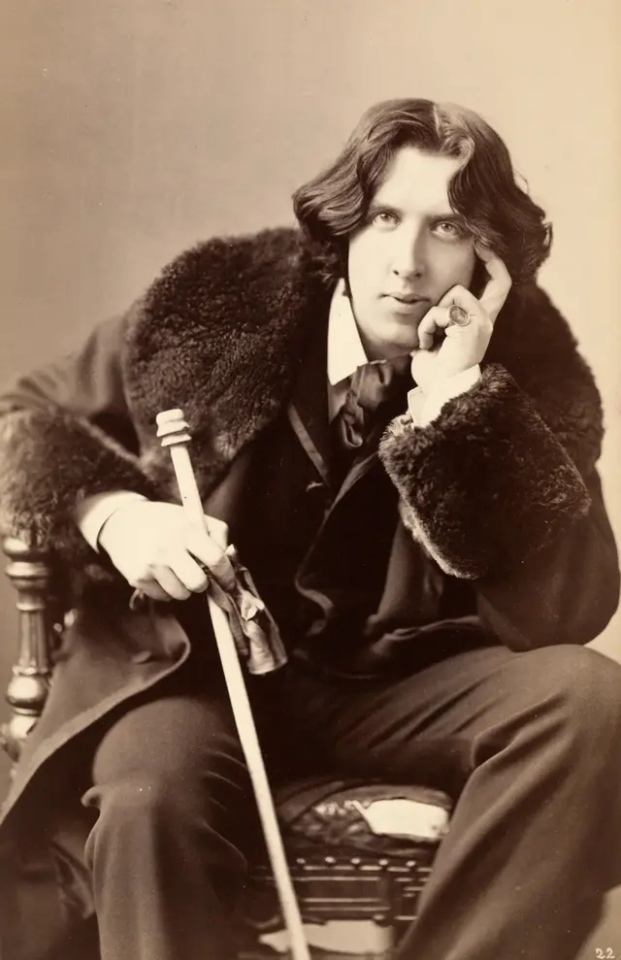
As fellow members of the Hundred Guineas Club, Oscar Wilde and Aziraphale would likely have been acquaintances.
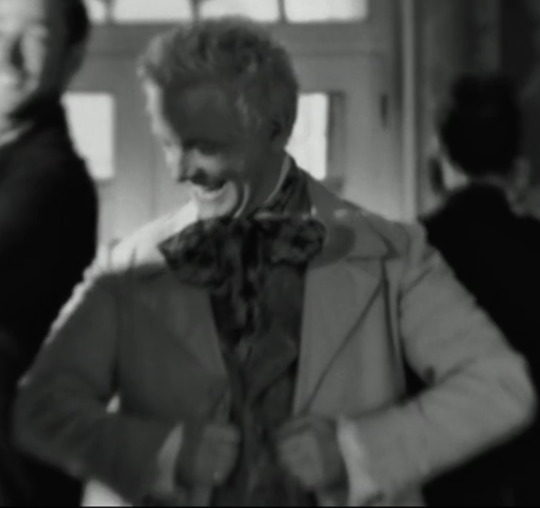
According to Wikipedia (ibid.):
"During the Victorian era, both single men and women uninterested in pursuing marriage could wear a ring on the little finger of their left hand."
This quickly expanded to a pinky ring on either hand. Here's Wikipedia's picture of farmer and philanthropist Caroline Rose Foster in 1917, the Edwardian era, wearing a pinky ring on her right hand:
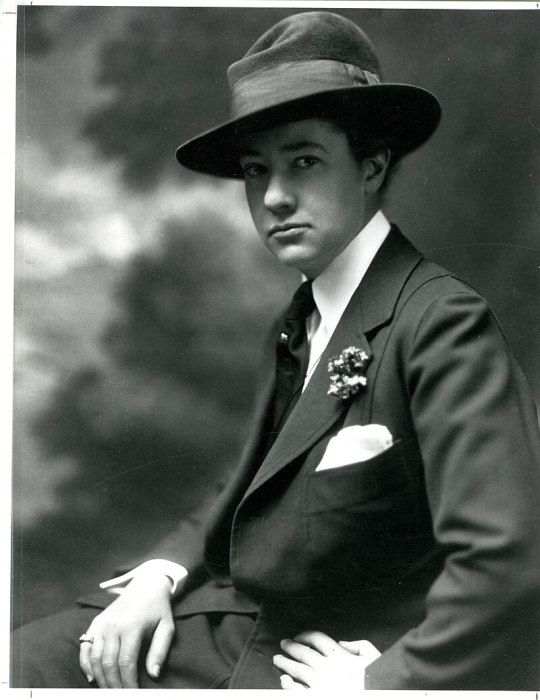
Do you smell a euphemism in "uninterested in pursuing marriage"? I do!
By midcentury--so only 30 years after Ms Foster up there--American and British queers, both men and women, were using signet pinky rings specifically to signal queerness to each other.
"For gay men in the 1950’s and 60’s, a way of signaling to others was through the wearing of a signet ring on the pinkie finger."
"During the 1950’s and 60’s signet rings were worn to signify membership of the gay community; both lesbians and homosexual men wore such rings."
The pinky rings @indigovigilance points out Maggie wears may mean she's an angel; they also match her midcentury lesbian style. Devious of the costumers to give her pinky rings on both hands rather than commit to one or the other.

Screenshot by @indigovigilance
To review, there are three reasons a person in Anglo-American culture might wear a pinky ring:
They just feel like it--This can be any kind of ring and can be worn on either hand or both
Professional affiliation--This is a signet ring worn on the left pinky finger
To signal queerness--This is a signet ring and can be worn on either pinky finger
Aziraphale has worn a signet ring on his RIGHT pinky finger at least since he repaired the Eastern "Gate" in the Wall of Eden, so I'm not suggesting that he adopted the 20th-century pinky signet trend to signal his queerness (although as a clockably 'gay' 'man,' Soho fixture, and member of the Hundred Guineas Club, he may well have started it). What I am suggesting is that Aziraphale has been given a ring by Heaven that Heaven intends him to use to show his professional affiliation, but as with the flaming sword he gives away, Aziraphale doesn't use the ring for its intended purpose. By wearing the ring on his right hand, Aziraphale removes the option of interpreting it as a symbol of his professional affiliation with Heaven and renders it strictly a personal ornament. He subverts a symbol of Heavenly menace into an object of beauty and queerness.
I mean queerness in both senses. If a human takes any symbolic notice of his ring, they'll note the signet is on his right hand and conclude Aziraphale is gay. If another angel takes any notice of it, they'll conclude Aziraphale is a bit odd--that he doesn't pay attention to the finer points of how to fit in with the archangels, doesn't do things like other angels do.
In conclusion, pinky signet rings as a queer signal are just the fucking coolest and I vote we bring them back immediately.
#good omens#good omens s2#good omens 2#aziraphale#aziraphale's ring#good omens lgbtq#pinky rings lgbtq#pinky rings as queer flagging#good omens angel rings#saraqael#michael#uriel#sandalphon
435 notes
·
View notes
Text
No, I don't think that RGU "subverts fairy tale narratives". On the contrary. I don't know how intentional the writing was on the writer's part but RGU's themes, structure, and resolution are much closer aligned to the Grimm-fashion fairy tales than the manicured opening sequence might make the viewer believe. At some points they do conciously reference fairy tales whilst alos having a good grasp on it's story contents. In fact, the opening sequence is less accurate about fairy tales than the actual plot of RGU.
Anyhow, actually a quick rambling how many fairy tale motives are in Utena. some referenced to, some overtly named, some just by my personal associciation:
The only fairy tale where the story is actually changed is Sleeping Beauty. There the visual reference is extremely strong with the duel plattform (a tower) being hidden in a forbidden forest, surrounded by thorns and roses, a princess waiting/sleeping (in her coffin) on a bed of roses. But unlike in the tale, the princess isn't woken up by the whimse of the prince but is allowed to choose if she even wants to wake up. [By the way, here's an essay comparing the pschycological literary interpretation of (The contemporary reading of) Sleeping Beauty with RGU.]
On the theme of girl locked away in a tower: Rapunzel come to my mind. Indeed Rapunzel loves her prince but he's also her co-conspirator as well as mean to escape her captivity. Their scheming is interrupted, both get horribly injured while attempting to escape. They both wnader around for a long time until their finally find each other. Scarred, they still are deeply happy to have found each other once more.
One OST track is titled "Bluebeard's castle". So fitting to be played in Akio's tower. The titular Bluebeard appears at first charming. Yet his bride discovers his secret chamber of previously killed women, relaizing what a monster her once so enarmoured husband is. It's a fairy tale beginning with a slight snese of unease, building up dread the longer the bride resides in the castle. What a perfect association for Akio's facade and body count of abuse.
The next Bluebeard in the making, Touga explicitly compares Utena with "the golden Goose"; In which every one tries to rip out the bird's golden feathers, creating a gigantic queue of greed. Even though Touga most likely wants to compare Utena to something precious worth exploiting, his comparison misses how the goose's doing finally made a princess laugh, and none actually was able to rip out the precious gold feathers.
Speaking of animals... In an conversation during which Nanami has a hard time naming her ever growing distress towards Touga's and her relationships, one statue in the background switches in the form of the "Musicians of Bremen". Nanami carriesway more animal associations than even Anthy. In fact Nanami turning into a cow is her being treated as domestic labour animal. In "The musicians of Bremen", labour animals are to be slaughtered after they can't labour anymore. So they flee their circumstances, band together (heh), and find a new home as band of misfits. Whereas the statue is a string of visual warnings about Nanami's dangerous situation, it gives me hope, that Nanami might, like the Bremen musicians, escape to a not glamorous but future full of support and friendship.
Last association coming to my mind. This is an entire free-falls association but with so many Utena-Nanami-paralles, why not make an animal comparison, too? Utena reminds me so much of the "Puss in Boots". Not destined to be anything but a cat, anything but a girl, she puts on clothing that shoul dnot be hers. It suits her quiet well. Yet the puss does it's deeds to help out their master who gave her the boots. They trick an evil magician with nothing but cleverness and ligt up their master into fortune. Utena doesn't help out of thanksfulness yet, like the cat, she does act out of care and adoration for the rose bride, and triumphs over a sinister figure that seemed once so overly powerful. LIke the wizard turning himself into a mouse, Akio turns out to not be overly powerful but actually a scared manchild who refuses to grow up, and actually isn't the allmighty figure he paints himself to be.
[Bonus: Saionji as the frog prince. Very serious analysis. Even though the popular image is one of a princess kissing a frog, and him turning into a prince, the actual tale is... not so gentle. The frog asks the princess to take hiom with her, in return to giving her back the ball that actually belongs to her. The princess feels humiliated having to play-act a romantic dinner scene at the frog's demands to sit on her side and be fed. Her protests are overruled by her father reprimanding her to hold her promise towards the frog. (Anthy mentioning how Akio is more like her father to her.) But the princess has her fill with the impertinent frog, throws him against a wall, and there: He becomes a prince. The parallels between Saionji getting beat up like a punching bag until he finally chills (somewhat) down are almost too obvious. Also, the frog and him share the colour green.]
In general, fairy tales often feature disempowered protagonists, often young women, most of the time they aren't even royalty. The protagonists often survive the most dire consequences by cleverness, resourcefulness but also their kindness to strangers - not raw power or powerful magic. I've no idea why people claim that retellings are "dark", "misbehaving", or "adult" because not only is it inaccurate to whom fairy tales were told, but even in format of children's publications, fairy tales are incredibly dark already. Children's fears of abusive parents, being neglected, mistrateatment, poverty, the world being scary being forsaken by mistakes by those who were supposed to care for the child, domestic violence, even incestuous abuse do feature in fairy tales - however, the protagonists survive the most dire of straits. Even if hurt in the process, they surivive, and "lived happily ever aftere". It's a faint, promise that they found happiness anyway. How similar it rings with "someday we will shine". If these common elements don't ressemble Utena's journey, and the circumstances of her friends, i don't know what else would bear a stronger ressemblance.
Apart from Anthy's and Akio's vague connection to godhood, and allegory, none of the kinds is special. Utena is a classic fairy tale orphan child, no special parentage, only her role as protagonist follows her fending off the darkness around her.
#RGU meta#Revolutionary Girl Utena#one of these days I will finish my long Utena-fairy tale essay. One day...!#(not kidding I spend already hours and 25 pages on this + academic lreading on fairy tales in Japan)
107 notes
·
View notes
Note
Hi, do you have any recommendations for Dick and Slade fics where their relationship is explored? It doesn't matter if it's a pairing or not. P.S.: I really love your posts
Thank you!!
And boy do I have them! All of these are my favorites. They're fics I specifically saved separately because I loved them. I hope you do too!
FAVORITE!! The thrill I get when I read this. The high. It's almost incomparable. Sladick in cyberspace. I don't even like cyber punk but I loved this fic - Gray Area
FAVORITE!! I talked about this one before but it's the perfect fic for apprentice Sladick. Read it so many times, I can't get enough of it. - Nightwing Protocol
FAVORITE!! This is one of my comfort fics, I love the whole collections so much. Slade and Dick get married and run off to the Maldives - I Guess Time Will Tell What the Come Down is Like
Slade comes for his Talon. That's his Dick Grayson dammit - Reclaiming an Owl
Favorite! I hope you don't mind but I'm sneaking in this Tiger/Dick fic forgive mee. Tiger's infuriatingly attracted to Dick's lips - Soft lips
FAVORITE!! Jedi Dick meets Sith Slade. And their relationship is always the same - Breathe With Confidence
Slade and Dick are soulmates much to the displeasure of Joey and the happiness of Rose - family in any form
Slade is a god of war and Dick is the demigod of shadows. They meet on the battlefield - Echoes of the Battlefield
Dick is a bartender. And Slade doesn't have identification - The Barkeeper
FAVORITE!! Dick is Aphrodite and Slade is Ares but Dick is a terrifying figure when spurned - Contradiction
FAVORITE!! Dick is Persephone and Slade is Hades and the story fits perfectly - When September Ends
FAVORITE!! Dick and Slade are both Alphas but that's not going to stop Slade in the force of his attraction for Dick - Ready or Knot
Favorite! Dick comes back with bruises, Jason thinks he lost a fight, Tim knows better, and the truth accidentally comes out - B is for Bruises
Series of prompts for Omega Dick and Sladick - Omega!Dick Week
Sladick if Dick had become Slade's apprentice from the start. He's coming back home - Home for the Holidays
FAVORITE!! Slade and Dick take care of each other - Follow Me (Don't Be Such a Fool)
Favorite! Slade takes Dick along South to a bar and Dick has some new discoveries - As Sweet As Strawberry Wine
Favorite! The whole collection! I really love the one with Deadshot but here's the first one with Slade! Remember when Dick paid of Deathstroke not to take a hit on Amy? Here's what happened after - Sell Your Soul
Slade's straight. So is Tiger. And so is most of the harem. They just like him - Attack of the Exes
FAVORITE!! The whole freaking collection?! Star Wars AU of Sladick. Taken to the dark side - Want is a Full Contract
Actually victoriousscarf's stuff is just too good - victoriousscarf
Dick basically goes fuck it. I'm tired of being good. and butts off to be slade's apprentice - Subverting Expectation
Favorite! Dick is a witch and the massive bloody wolf at his door is obviously just a wolf, right? - My Beloved Deathstroke
Slade can't just let Dick stay as Ric. He's too good for that - Madness Started the Moment We Met
FAVORITE!! Ric meets a man at the fight club. And that man is a little too interesting to let go - Like a Virus
FAVORITE!! Dick receives some interesting videos from Slade. Slade has always been good at enticing Dick - Puppet Show
FAVORITE!! Supernatural AU where Dick is Sam and Slade is Ruby. Jason's gone but Dick's gonna get his little brother back. No matter what it takes - On the Head of a Pin
FAVORITE!! Same as above! - Point of Fracture
FAVORITE!! I will sink my teeth into this collection and shake it because it's so good. YJ! Dick becomes the spy instead of Kaldur - Foundations
Favorite! Slade visits Dick in the hospital but Dick's not awake. Although Mar'i is - Give Us This Day
FAVORITE!! Midnighter/Dick/Slade. Dick's gone, right? Then who is then man with a swirling face that reminds Slade of him? - The Third Kind
Favorite! Dick is a sailor and Slade is a merman - I am a Sailor, and you are the Sea
Another Star Wars AU - Resolute in Resurrection
FAVORITE!! Slade acted so unaffected before. There's none of that now - every shadow filled up with doubt
Dick swears he's only here to rescue Damian. It's not his fault Slade was also locked up - (practice our prayers) until some hope crystallizes
FAVORITE!! Dick's mother always told him never to deal with the Fae. But some situations call for it - deal with the devil
FAVORITE!! They had a deal. But Slade's deal never was supposed to be about catching feelings - Maroon Haze
FAVORITE!! Dick has magic and Slade is cursed - i have hurt and hungered before (flesh against flesh)
FAVORITE!! I have read this fic over and over again. I love the younger Slade and Older Dick dynamic - running fever
Not a ship
FAVORITE!! When Slade took in Robin as an apprentice, he was a kid. A teenager. Get woke slade. Funny!! - Why did I think this was a good idea?
Dick is Robin and Slade's protective father instincts kick in - Made Peace
FAVORITE!! One of my all time favorites. Dick's name gets pulled out of the hogwarts cup as the Hogwarts Champion. But..he never put his in - heavy is the crown
Favorite! Bruce doesn't get to get away with Spyral. Dick leaves Bruce for Slade - deeds of men depraved
I have way more but this is a good starting point I think. Lemme know if you're interested in more!
276 notes
·
View notes
Text
Character Development in Different Genres: Tailoring Personalities to Fit Your Story's Needs | Part I of Character Development Series

When it comes to writing, one of the most exciting and challenging aspects is creating compelling characters. Whether you're penning a thrilling mystery, a heartwarming romance, a gripping fantasy, or a thought-provoking literary novel, the characters you bring to life play a pivotal role in captivating your readers. However, not all characters are created equal, and tailoring their personalities to fit the specific requirements of your chosen genre is essential for a successful and engaging story.
So, how can you ensure that your characters shine in the context of their genre? Let's embark on an insightful journey into the art of character development across different literary landscapes.
The Foundation of Genre-Specific Characters
Before delving into the intricacies of character development, it's crucial to understand that each genre comes with its own set of expectations and conventions. While a hard-boiled detective might thrive in a gritty crime thriller, they might feel out of place in a whimsical fantasy world. Therefore, the first step in crafting genre-specific characters is immersing yourself in the nuances and tone of the genre itself.
For instance, in a fast-paced action-adventure novel, the protagonist is often characterized by their resourcefulness, courage, and determination in the face of danger. On the other hand, a character in a cozy mystery may possess a keen eye for detail, a sharp wit, and a knack for uncovering secrets amidst the charm of a small town. By understanding the core elements of the genre, you can lay a sturdy foundation for building characters that resonate with the expectations of your readers.
Investigating Character Traits Across Genres
Let's take a closer look at how character traits can be tailored to suit different genres:
1. Adventure/Thriller:
Courage and Resilience: Characters in this genre often face high-stakes challenges and adrenaline-pumping situations. Their ability to confront danger with courage and resilience is a defining trait.
Quick Thinking: Whether escaping a treacherous trap or outsmarting a cunning adversary, characters in adventure and thriller novels are often marked by their ability to think on their feet.
2. Romance:
Emotional Depth: Characters in romance novels thrive on emotional connections. Their vulnerabilities, hopes, and desires form the cornerstone of their personality.
Charm and Passion: A touch of charisma and passion can elevate romantic protagonists, making them irresistible to both their love interests and readers.
3. Fantasy:
Imagination and Wonder: In the realms of fantasy, characters embody boundless imagination and a sense of wonder. Their belief in the extraordinary and the magical defines their essence.
Epic Journeys and Destinies: From chosen heroes to enigmatic wanderers, characters in fantasy often carry the weight of epic destinies and monumental quests.
4. Mystery:
Curiosity and Intellect: Mystery protagonists are marked by their insatiable curiosity and sharp intellect. Their inquisitive nature drives them to uncover the truth hidden within the enigmatic plots of their stories.
Intrigue and Suspicion: Characters in mystery novels often harbor secrets of their own, adding layers of intrigue and suspicion to their personas.
Crafting Characters with Genre-Specific Flair
Now that we've glimpsed into the distinctive traits that define characters across genres, it's time to infuse our characters with that genre-specific flair. Here are some creative strategies to tailor your characters to fit the unique demands of different genres:
1. Know Your Readers:
Before sculpting your characters, get to know your intended audience. Understanding their expectations and preferences within a particular genre can guide your character development process.
2. Subverting Tropes:
While adhering to genre conventions is important, don't shy away from subverting tropes to inject fresh and unexpected elements into your characters. This can breathe new life into well-trodden genres.
3. Embracing Authenticity:
No matter the genre, authentic and relatable characters are the cornerstone of captivating storytelling. Infuse your characters with genuine emotions and experiences that resonate with your readers.
4. Reflecting the Setting:
Characters are not isolated entities; they are shaped by the worlds they inhabit. Reflect the essence of the genre's setting in your characters' mannerisms, speech, and worldview.
5. Dynamic Character Arcs:
Consider how your characters' arcs can align with the thematic essence of the genre. From personal growth in literary fiction to valiant heroism in fantasy, tailor their journeys to harmonize with the genre's spirit.
The Power of Balancing Familiarity and Innovation
While it's essential to cater to the expectations of your chosen genre, it's equally vital to infuse your characters with a spark of innovation. Readers are drawn to characters who feel both familiar and refreshingly unique. By blending genre-specific traits with innovative twists, you can create characters that stand out while remaining rooted in the essence of their genre.
Unleashing Genre-Defying Characters
In the ever-expanding universe of literature, the art of character development is a dynamic and thrilling endeavor. As you embark on the journey of crafting characters for different genres, remember to immerse yourself in the heart of each genre, cultivate characters with depth and resonance, and balance convention with innovation.
Ultimately, the characters you create have the potential to transcend genres, captivating readers across a diverse spectrum of storytelling. So, unleash your imagination, breathe life into your characters, and watch as they navigate the rich tapestries of diverse genres, leaving an indelible mark on the literary landscape.
So, fellow writers, as you embark on your next literary odyssey, may your characters be as diverse as the genres they inhabit, and may their stories resonate with readers far and wide.

Happy writing! Warm regards, Ren T.
#writing#on writing#CharacterDevelopment#WritingLife#WritersCommunity#GenreSpecificCharacters#LiteraryWorlds#CraftingPersonalities#AuthorAdvice#StorytellingTips#CreativeWriting#CharactersOfTumblr#creative writing#writing tips#thewriteadviceforwriters#writers block#writeblr#how to write#writers and poets#character inspiration#original character#character design#character concept#character sheet#character development
196 notes
·
View notes
Text
This Is About Relationships (Hell's Greatest Dad)
I feel like we are seeing more and more stories that draw on horror elements as of recent times, with mixed success.
Critical Role, for example, has put some heavy emphasis on body and cosmic horror in their most recent campaigns, and I think that has worked really well. They are telling a story about feeling powerful in the face of adversity, and so having villains who are either unknowable or far too knowable really works for that idea.
On the other hand, the horror elements of Doctor Strange and the Multiverse of Madness actively took me out of the story, because they didn’t fit with the rest of the franchise at all, and I found that rather jarring.
Then there is Hazbin Hotel, which isn’t scary, but it definitely draws on some of the tools of writing horror. Although it doesn't do that in the way you might expect. Specifically, it uses the character of Lucifer to both embody and subvert the very nature of Gothic horror itself.
Let me explain.
SPOILERS AHEAD: (Hazbin Hotel, Ratatouille, Paradise Lost, Frankenstein)

I have made my stance on genre extremely clear in the past. I think it exists, but I think it is bollocks, and Hazbin Hotel kind of proves my point.
Because, yes, you can boil Horror down into however many constituent parts as you would like in order to organise a bookstore, but however you spin it, Hazbin Hotel fits that, with the exception that it isn’t scary.
Then again, being scary is entirely subjective. For example, I am completely fine with ghosts and ghouls, so the only thing that gets me about games such as Phasmophobia are the jump scares, and Jump Scares aren't horror. By the same score, I am incredibly squeamish, so Hazbin Hotel itself was more difficult for me than a few of my friends.
Which leads me to gothic horror, which has a distinct aesthetic to it that isn’t actually essential at all.

The name actually comes from its aesthetic. Gothic fiction got started in the 1700s when Gothic architecture was popular but gained traction in the early 1800s when authors such as Edgar Alen Poe and Jane Austin got involved. The latter of whom wrote Northanger Abbey in 1818 to parody the overdramatization of the genre in a book that I personally despise.
Austin’s book comes across to me as incredibly insincere. I have an infinite respect for Austin’s work, but there is a deep sense of contempt in Northanger Abbey that drives me up the wall.
I want to be clear here, this is not me saying the book is bad. It is incredibly well written. I just hate it with every fibre of my being.

To me, Northanger Abbey missed the point of the gothic genre. Gothic isn't about the emotion, it's about the humanity. The fallibility, the force of will, the instability and resilience that come and go like the wind.
Gothic horror turns that into fear, specifically the fear of morality. It’s the Ratatouille genre. Any angel can sin, any demon can rise. Or in other words:
“Anyone can cook.”
Gothic horror is the fear of inconsistency. That someone you trust can betray you, or spiral into awful deeds, or that someone you despise might be right. It’s the fear of redemption, and conversely, the terror of good motives leading to bad ends.
Other subsets of horror draw on the fear of the unknown, or of not knowing. Gothic fiction is steeped in the terror of what you know being wrong.

Case and point, Frankenstein is both the archetypal science fiction book, and a phenomenal Gothic story. The terror is derived from the fact that it’s titular character can be so great and yet such an absolute monster, as well as the horror of creating a conscience.
The creature is intelligent, and its intrinsic morality is up for debate the entire time. Frankenstein calls it his "Adam", for Pete's sake. It kills multiple people, but as a reader you are unsettled by how much you agree with its motives.
Gothic horror is the fear of absence. There is no good or evil here, just people.

There’s a reason I brought up Ratatouille. The conflict of the series is derived from Skinner’s visceral fear that someone he despises as much as Linguine can actually be competent, combined with a field rat rising from the gutter to run a restaurant. “Anyone can cook” is a threat in this movie, but it gets better explained by Ego in a way that I really like.
“In the past, I have made no secret of my disdain for Chef Gusteau’s famous motto: ‘Anyone can cook.’ But I realize, only now do I truly understand what he meant. Not everyone can become a great artist, but a great artist can come from anywhere.”

According to one of the greatest fanfics ever written, Paradise Lost, Lucifer rebelled against G-d’s vision and fell, which can be taken any number of ways. It’s written so that you sympathise with the main character, who is, may I remind you, the literal devil.
Worth noting, Frankenstein's monster reads Paradise Lost. I wonder if there is any significance to that.

Lucifer from Hazbin Hotel is nominally the same character as his biblical counterpart, except that he is blissfully unaware of any of the themes surrounding him. Kinda.
He has grasped the fact that anyone can fall, but the reverse of that hasn’t quite registered to him yet.
Case and point, he doesn’t understand people at all. He has sought escapism through “stuff”. By which I mean the ducks, but I also mean his song, Hell’s Greatest Dad.

Part of the gothic theming in Hazbin Hotel is that people aren’t static, and that relationships are more important than anything else. Angel Dust and Pentious don’t become better people through trust falls, the find it through love and companionship, both platonic and more than platonic.
To demonstrate this, we contrast Lucifer with Alastor, who once again doesn’t sing his own song but steals it off someone else. Alastor’s relationship with Charlie is so obviously sinister, and that will be better explained two episodes down the line, but at least he has a relationship with her.

The agony of this is that Jeremy Jordan is a phenomenal voice actor, who, along with Lucifer’s stellar writing, endears the character to you from his first scene.
Alastor is a villain; Lucifer is an absent father. Who do you side with here? That’s gothic fiction.

“Sailors fighting in the dance hall, Oh man, look at those cavemen go. It’s the freakiest show. Take a look at the lawman Beating up the wrong guy Oh man, wonder if he’ll ever know He's in the best selling show. Is there life on Mars?”
This is the chorus of a David Bowie song called Life On Mars. It centres around someone seeking escape through television and storytelling. It points out the futility of this, but the fact that it works. It’s a stable dynamic that doesn’t go anywhere.
Remind you of anything?
“Who needs a busboy, now that you've got the chef? Michelin tasting menu, free à la carte I'll rig the game for you because I'm the ref Champagne fountains, caviar mountains, that's just to start!”
Lucifer is offering Charlie anything she could dream of. Any thing. But Charlie doesn’t need an object. She needs a father, and she needs her relationship with Lucifer.

Enter Alastor, who, up to this point, has been generally benevolent to Charlie. He’s basically the embodiment of that old Tumblr textpost that described someone as “chaotic gay. I haven’t done anything evil yet, but my general aesthetic and demeanour tell you that I will, any day now.”
Side note, I know this post exists. I have seen it, I have screenshots of it. But Tumblr’s search function is so legendarily awful that I cannot locate it. Tumblr’s search function has beaten the FBI before, and I don’t have that much patience.

In any case, Alastor offers up his own curriculum vitae in the form of this:
“Who’s been here since day one? Who’s been faithful as a nun? Makes you chuckle with an old-timey pun? Your executive producer.”
He’s pitching himself via his relationship with Charlie. But what I wanted to point out specifically was how the two characters relate to the beat of the song.

This song is inspired by Friend Like Me. I know it's subtle, but I'm onto something, and I can pick out the clues. If you look closely at his moustache in this shot...
Lucifer is clicked to the rhythm, or rather, his backing music is. The band hits ever downbeat as one, looping back to play the same thing every few bars. It is incredibly stable. The one thing that isn’t, is Lucifer.
The man misses every single beat by a fraction of a second. Not much, but when you contrast him with the entirely of the rest of the song, you notice that tiny imperfection, especially when Alastor doesn’t share it.
Alastor starts singing by matching the beat perfectly with his opening sounds, then going free within the restraints. Later, when he co-opts the song, the band begins playing along with him and matching his melody.

The Radio Demon understands people incredibly well, and he works on relationships. As such, his music has a much more symbiotic relationship between each of the parts. Lucifer’s feels like a creation, Alastor’s feels like it was created, if that makes sense. There’s a human element to Alastor’s take on this song.
Which brings me back to the gothic stuff going on here, and the relationship between Lucifer and Alastor. Alastor is, of course, a manipulator. He takes issue with Lucifer because he wants Charlie isolated. But Lucifer has no reason to get upset by Alastor, right?

Alastor shakes up Lucifer’s entire worldview, to the point where I find some of the double dad dynamic between them rather compelling. Most of it.
Alastor is risk incarnate; he stands for the idea that anyone can do anything. A radio presenter can be a cannibal, and have parenting instincts take over with Nifty and at times Charlie. But he is unsafe. Because he is such an unknown, he is untrustworthy. You don’t know where you stand.
Lucifer, meanwhile, is terrified of this fact. He likes the safety of knowing where he stands, he can protect himself there, but he can also protect others. In my eyes, that’s why he was so absent with Charlie. He found something he could understand and kept it because he didn’t want to shake up the rhythm. But that was futile, and he realises this over the course of this episode.

But you might say “wait, Alastor is ace, he can’t be with Lucifer,” and my answer is twofold. First up, I am ace too, that doesn’t prohibit relationships. I’m not even talking about romantic stuff here, Alastor is the poster boy for being aromantic, but more importantly, parenting isn’t just about the other parent.
The two can both be dads, joined by their mutual care for their daughter, rather than affection for each other. I find that compelling. Charlie needs both the security and the sign that everything is possible. She needs someone to lift her up, but she also needs someone to catch her when she falls, and Lucifer and Alastor both play different roles in that dynamic.
Any angel can sin, any demon can rise. Anyone can be a dad, anyone can cook.

Final Thoughts
Jeremy Jordan is a global treasure and even if this series doesn’t stick the landing with its next season (we will see), Lucifer will be amazing.
Do I have a crush on this man? No. No, I do not. Why do you ask?
In all seriousness, I think episode five should have been two episodes. One for this song, and one for the next. Lucifer would join the Hotel’s crew for a few days, befriending Pentious and co., being utterly disrespected by Husk, and being eased into the fact that morality isn’t binary.
I don’t even mean this from just the pacing perspective, I think the series would have so much more thematic weight if it devoted more time to the literal devil learning the thesis of the series and becoming on board with redemption. I think that would be cool.
I'm also just now realising that this is a Gothic Horror musical, so of course Alex Brightman got cast in it.
In any case, next week is More Than Anything, which is yet another case study in why Jeremy Jordan is amazing. Stick around if that interests you.
Previous - Next
#rants#literary analysis#what's so special about...?#literature analysis#character analysis#hazbin hotel alastor#hazbin hotel lucifer#hazbin alastor#hazbin lucifer#jane austin#mary shelley#mary shelly's frankenstein#david bowie#life on mars#gothic horror#gothic literature#paradise lost
42 notes
·
View notes
Text
A Deity Work Primer
The following paragraphs are a discussion of deity work, with a focus primarily on safety and responsibility. Everyone needs to feel safe enough to work with their gods personally; no one should tell you how to worship. Two disclaimers apply: first, I use the word 'worship' as a loose and accessible term for deity work, due to its dual noun/verb nature.
Second, I hold these opinions steadily enough that I will not take offense if you merely disagree. If it doesn't work for you, it doesn't.
But I do not accept the use of blatant fallacy to discredit or invalidate the work of others. If it works for them, and does not hurt you or your community, let it be. All said, let's begin. What are gods?
The only consistent answer for this is that gods are story incarnate. Gods are the things we see, love, and fear in ourselves, nature, our works, and other people. Gods cannot be blamed for a war, a famine, the greed of a pastor or the crippling doubt you are experiencing. They can only be credited with doing their jobs, because they do not act outside of their domains. Ares favor falls on the victor- but that's just a story. Both sides of the battle will be praying fervently to their war gods, but only one will win, and then credit theirs with being mightier.
Who was really mightier, though? The soldiers, of course. But war is inhumane, and as long as we can credit a god with our victory, the atrocities will be cast as preordained. Gods don't have the same standards men do.
Gods are the point where our consciousness intersects with things that are out of our control. I hate to offend some folks- but we were here first. We retconned history so that the gods were immortal and eternal, and because we all believed it, it became true- but only for the people who believe it.
Worship and Free Will
When you begin your journey, the road is often littered with claims that 'your gods will choose you', or that you MUST wait for a spirit to reach out before beginning worship practices.
It's your choice, though. Nobody seems to want to admit that, to themselves or anyone else.
If you are interested in practicing deity work, the gods have already chosen you. It is your responsibility to know them, reach for them, speak to them, now. Similarly, it is your responsibility to maintain their sacred space, and make offerings appropriate to their domains, and (the BIG one that everyone misses) live in accordance with the values they represent.
Which brings us to the next point:
How to Know Your Gods
I'm going to use my gods as examples here, because I feel that it would be unfair to make claims about anyone else's deity work without providing my basis for comparison.
I worship Loki (the God of Mischief), Mephistopheles (the Shrewd Merchant), Auberon (the Autumn Lord), and the Sand-Man (God of Bedtime Stories). I also work with personal manifestations of the cardinal elements, and am friendly with the local sylph (air-spirits). Do you see a pattern? Gold and orange and darkling purple, bonfires at dusk, travel hard and sleep harder. Make yourself at home wherever you go, subvert expectations, and talk your way into or out of anything you like. Everyone is a friend until proven an enemy, and no enemy will be forgotten for their crime. Tell tales for the children, the hungry, the old.
These are the tenets of my faith, but reader, I did all of that before ever meeting my gods. I worship these gods because I agree with their values- not vice versa. If you have to agonize to fit the 'ideal' practitioner for your god, by giving up parts of your own being, seek out somebody else. Tricksters and Teachers
Some gods, of course, show up out of nowhere. You will go about your business, and suddenly Baba Yaga shows up and asks you to take care of her spider. Janus offers you a life-altering decision that shatters your mental health for years. Eros pulls one over on you and you find the love of your life. Sometimes, worship is not the goal. Tricksters are often vilified, but their original function was CHANGE. "The way your world works isn't serving you or your gods. Monotony has overridden the function of your practice. Let's shake it up." The lessons taught by the random arrivals of gods are intentional; if your knee-jerk response is to kick them out and triple-lock your wards, you might want to consider your relationship with change and personal growth.
Back to free will, though- you don't fucking have to. Not a single god will take offense to the polite decline of their offer. Most trickster gods will even be ecstatic if you pull your magic weapon on them before you realize who you're dealing with.
Respect for Gods and Sacred Space
I have one rule, and one only, in regards to gods and temples: your personal practice doesn't mean a damn thing at a temple, circle, or sacred gathering. Even Loki acknowledges that the only person he needs to speak for him at his holy rites is the appointed priest/channel/etc. Your work, in your home, is going to be completely different from anyone else there, so stick to what you can all agree on, and leave points of contention to the highest authority at the gathering.
In other words, respect your deity by respecting the other practitioners of that deity.
Offerings
Everything is an offering, friends. If I make a good sale, I make it in Mephistopheles' name. If I prank my partner in a well-played jest, I am honoring Loki. Every story I write is an offering to the Sandman. Every pot of chili or apple pie is dedicated to Auberon. If you are doing something they would take pride in, you are making an offering.
Your altar is for ritual, but your worship extends far beyond its immediate surroundings.
That's all for the time being. To summarize, the gods are collective concepts, worship is a choice, and respect is more easily applied to humanity than it is to ever-changing deific personifications.
Take what you will, discard what you won't.
With love from this long-winded madman.
#witchcraft#magick#pagan#witchblr#baby witch#spirituality#ritual#folklore#mythology#greek mythology#norse mythology#demonology#the fair folk#deity work#polytheism#paganism
35 notes
·
View notes
Note
okay, if you're open to discussion, here's my view on why i think your mithrun take is somewhat reductive - prefacing this with yes, i understand you're talking about thematic positioning and not individual character motivations or goodness/badness, and no im not a particular stan of him or a kbms shipper or anything, if that helps you take this as discussion in good faith. (anon because i'll admit all the "ugh everyone who disagrees with me DOESNT KNOW HOW TO READ" does discourage from directly engaging!) yes, the elves are imperialist and yes the canaries are the primary arm we see of that in the story. yes, To A Point the violent manner that they, including mithrun, approach the problem of the dungeon is a reflection of this - it's not a coincidence that kui put this character ON this team. but when the discussion of it comes down to mithrun as the "representative" of this is where you lose me. in certain moments you could say he Acts as that, but it's not really the whole story of what his character is about or how he fits into the overall picture. multiple key moments are when mithrun notably acts AGAINST what the rest of the canaries would do, choosing to put (some amount of) trust in a tallman - we can have different reads on how much trust it is, but the effect definitely is that their approach is given a chance when normally the canaries do not allow that. the moment of asking kabru what he wants to do and following after laios, and Especially the moment of giving laios the go-ahead to try and defeat the demon, very much coming into conflict with flamela over it - in both of these scenes the other canaries represent the normal elven imperialist approach, and mithrun deviates from it. sure he thinks he regrets it a few minutes after the second one (because it did look like it failed, and because he's not exactly completely anti-imperialist either) - but in terms of what his character represents in the story, those moments are crucial to the ultimate "happy ending", and they're important TO the anti-imperialist theme that mithrun, the one with more personal reasons for being in the dungeon rather than simply being a canary & carrying out the empire's will because it's their job like the others, ISN'T acting on its side the whole time.
See this mentality is a little puzzling to me, because it treats my + others' speculation on the threat of imperialism in the story and Mithrun's role in it as if we created some sort of strict binary? As if he represents only this one singular thing, and doesn't share that role with anyone else, or that he needs to be condemned for it, etc. I don't think they're all passing around a "who represents imperialism and who subverts it" stick.
I mean, the story isn't very interested in that, is it? I believe in meeting a piece of media where it's at, which is why I'm not trying to hashtag cancel anyone over liking the elves or whatever. Dungeon Meshi is a story about ecosystems and food and hunger. It is very aware of the forces that create the situations around hunger, but ultimately it is mostly interested in food as the great leveler. We all need to eat and we all deserve to do so, even the people we might have considered enemies an hour ago.
The Canaries all get a seat at the literal and metaphorical table, even though, textually, they represent a world power whose monarch says, on page, that they are going to continue to monitor Melini and the people involved (this is a threat). Another story might not be forgiving of this. But Dungeon Meshi is not trying to be a political thriller, though as I've said, it is very aware of these things.
I, personally, am interested in the way Mithrun's story arc functions. If I talk about Mithrun, it's because he is a main character. Fleki, for example, is not a main character. Neither is Flamela. The Canaries are an antagonistic force (and not in a traditional "evil that needs to be defeated way", but antagonistic nonetheless!), but Mithrun is literally the representative of this force as the only one among them given a focus. And also because he is the captain of their squad. Even Flamela is only vice captain. Mithrun's motivations drive the Canaries as an entity in the story the same way his orders as their superior officer drive them as people.
So I am mostly interested in talking about violence, and to do that, I would be remiss to not touch on the circumstances that empower that violence. I cannot pretend like Mithrun does not arrive in the dungeon as the military officer of a first world power whose squad has the ability to arrest (and potentially execute) anyone they want, or that their success won't spell a de facto takeover of the region.
Does Mithrun care about that? No. I mean, I don't even think the other elves really care about that. It's kind of a moot point. They have a genuinely good reason for being in the dungeon and doing what they do, but they are still dangerous.
So when I touch on imperialism, which, again, is textually a part of the background of Dungeon Meshi, what I mean is: Mithrun's actions serve imperial interests regardless of his personal feelings, and they align with the threat of imperialism because oppression is inherently violent. That is where the comparison comes in.
If I were writing some sort of thesis on colonialism in Dunmeshi, I would say that the way Mithrun literally objectifies people- grabbing Kabru, ignoring his consent, using him as a projectile, brutalizing Thistle and Marcille- are physical manifestations of that inherent violence. The complacency of the other elves- their very punch clock villain natures- also serve the interests of imperialism. They're all in it together, they just disagree sometimes on the method. If Mithrun had gotten his way, the elves would have taken over the dungeon.
You are right that Mithrun comes into conflict with the other Canaries, and this is because Mithrun barely cares about sealing the dungeon. His one desire is his quest against the demon. This superficially aligns with the Canary's overall mission, but he will jeopardize that mission, the way he jeopardizes lives, for his personal goal. I don't really consider this an anti-imperialist metaphor even if it does eventually lead him to go against the Canaries' interests in trusting Laios. It's good he does that. It fits with the overall theme of disparate peoples uniting for the great leveler of hunger. Because, crucially, Mithrun agrees to it when Laios insists that he can defeat the demon. He isn't swayed by anything else. I do also think it's important that the one time he doesn't escalate to violence represents a moment of cooperation among these groups of people. We can say that Mithrun's self interest is better served by community than by state-sanctioned violence (and I do) but it doesn't cancel the rest of it out.
I'm also going to have to disagree with how much he trusts or respects Kabru. I would love if Mithrun did either, but the more I re-read the manga the less I'm sure of that. I think he sees Kabru as a useful tool. Again, I do not say this as a condemnation. I think Mithrun is nearly incapable of caring about anything else before the end of the story: I think his desire for the demon, his helpless hatred and self-immolating revenge, is so big that it blots out everything else for him. It's a tragedy. Mithrun is not entirely a rational actor, the way that someone in the grips of a debilitating addiction isn't.
You are free to disagree with me on this. I think I have an accurate reading on it, but I realize there is a lot of wiggle room.
My personal conclusion is that this


is a very long joke.
It sets you up to think that Kabru got through to him, that they are united against Laios, that they might have even achieved some level of camaraderie after their bottle episode.
Then Kabru and the Canaries show back up, and Kabru is ... handcuffed.


I didn't notice this the first time I read the manga! Kui does not draw any attention to the tiny magical cuffs, and the deliberately awkward way he holds his wrists for the next ten chapters didn't really hit for me until I had gone back over it. At this point I think it's supposed to tease how much Kabru is cooperating with the Canaries and how much of a threat he'll still poses to Laios.

It did not hit me until a second read that the punchline to this little arc is that Mithrun agreed to Kabru's idea because he had decided to use Kabru as bait. This is the equivalent of staking Kabru out to lure Laios and the others so that they'd let their guards down. Kabru looks very put out by it, he's still handcuffed, and he's got the surveillance state bird keeping him in line. This is not the situation of a guy who is trusted and respected by the person who put him in this situation. In hindsight, it almost makes Mithrun's agreement a joke in itself. "Oh, you wanna talk to Laios? Sure. Let's go do that. Hold still."
It recontextualized their time together for me. Made me notice how interested Mithrun was specifically in what Kabru had to say about this Laios guy.



You can kind of see the gears turning in his head. He correctly deduces that Laios is closest to the dungeon's heart. Therefore, reaching Laios will take him right to the demon. I don't think he actually cares about what Kabru wants. After all, Kabru says he wants to talk to Laios, and Mithrun doesn't let Kabru do that. He doesn't want to try Kabru's methods. He barely seems to think about Kabru at all.

We are treated to a three-chapter sequence of Mithrun and the other Canaries cornering a group of people they intend to arrest, interrogating them, intimidating them, and then Mithrun, especially, escalating the situation to near-lethal violence. Marcille releases the Winged Lion because she is menaced, talked down to, terrified, and injured. Even the other elves are appalled by how brutal and erratic Mithrun acts.
And that's what Mithrun's story is to me, actually. It's the very dark spiral that pain can send you down. It's about how his obsession is killing him. How it's keeping him from forming meaningful relationships. How it hurts the people around him and causes him to act cruelly. He cannot be reasoned with before he crashes and burns. If he had grown or changed as a person at all before the climax, his character arc would be less impactful. He has to tear through everything to get to the demon, look the demon in the face and be told point blank that he doesn't matter to it. He has to put all his energy into this path of violence to show how utterly impotent and self-destructive it is.





Dungeon Meshi understands the violence we all must do as living creatures. The inherent selfishness of killing and eating in order to survive, or fighting to protect yourself. It doesn't condemn that. It doesn't condemn the violence you do when you feel backed up against a wall either. But it does not reward this. Mithrun's all-consuming desire for revenge- and it is revenge, this is functionally a flailing quest for revenge even if he also wants to be finished off as a result- is as poisonous to him as the demon's bottomless appetite was to it.
Mithrun does not once stop to help anyone else during the climax. All the other characters converge to work together, even to put aside their enmity (like the elves and the orcs) to try and stop the threat. He doesn't turn away from his single-minded pursuit to help anyone, protect anyone, or heal anyone, though it's obvious that he could have done more good fighting by the others' sides rather than throwing himself at the demon over and over. Even the idea that he might help someone- the moment where he slaps Kabru out of a panic attack, but only because he genuinely wants to punish him- is treated as a joke.
It's only after all of this has occurred, and left him utterly empty, that Mithrun can stand up again as a new person. After he's looked into that yawning void straight on and realized what it meant to pursue it, where it was leading him. He gets up again because he agrees to share a meal. And because he agrees to help feed others.
Rage doesn't serve you. Community does. That's where his happy ending comes from. And maybe this is not the most thorough exploration of even this single topic, but I don't think I'm being reductive.
If I seem frustrated, it's because people have turned me into a ridiculous strawman because of these ideas, and then spent months shadowboxing that strawman while calling me a dumb pretentious cunt over it. This is often very funny, but even I have a tipping point. Good night.
#Dea's anonymous friends#Dea answers#dungeonposting#I took adderall for the first time right before this ask appeared. hi.#I would have written all of this without it ... probably#IF YOU SAW THIS BEFORE I WAS DONE WRITING ... I HIT SOMETHING ON MY KEYBOARD OML#thank fuck it didn't delete everything or I would have died#it is 1:30 AM#musings with Dea#I'll probably never make this rebloggable because I don't want to be adversarial to the asker#and I'd still rather make a formal post about these ideas without any connection to my personal bullshit
40 notes
·
View notes
Text
The Greatest Robot on Earth: Astro Boy and Pluto Part II
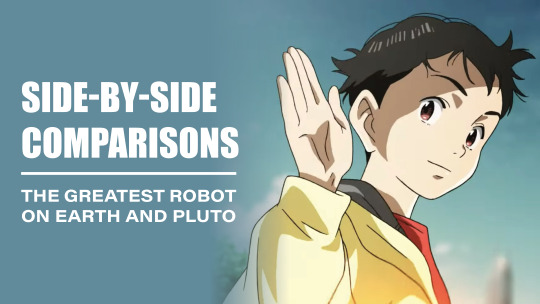
Part I is here. This side-by-side continues in part III here, or you can read the whole thing on Ao3.
Side-by-Side Comparisons
“The Greatest Robot on Earth” and Pluto
The best place to start in comparing these series is their summaries. This summary for “The Greatest Robot on Earth” comes from the 2002 Dark Horse release:
“In the novel-length "The Greatest Robot on Earth," a wealthy sultan creates a giant robot to become the ruler of all other robots on Earth. But in order for that to happen, he must defeat the seven most powerful robots in the world, including Astro Boy, who must have his horsepower raised from 100,000 to 1,000,000 to face the challenge! And his sister, Uran, also flies in to lend a helping hand!”
Well, besides the fact that Uran doesn’t actually fly, I suppose that’s true enough. Gotta love marketing copy.
And here is Viz’s summary for Pluto: Urasawa X Tezuka, vol. 1:
“In an ideal world where man and robots coexist, someone or something has destroyed the powerful Swiss robot Mont Blanc. Elsewhere a key figure in a robot rights group is murdered. The two incidents appear to be unrelated...except for one very conspicuous clue - the bodies of both victims have been fashioned into some sort of bizarre collage complete with makeshift horns placed by the victims' heads. Interpol assigns robot detective Gesicht to this most strange and complex case - and he eventually discovers that he too, as one of the seven great robots of the world, is one of the targets.”
An ideal world, eh? Well, I’m all about subverting surface appearances, so I like it. Anyway, right off the bat, we can tell that these two series aren’t the same genre, aren’t using the same principal characters, and aren’t concerned with the same stakes. They seem to only have one thing in common: the word “robot”.
The following pages for “The Greatest Robot on Earth” are from the Dark Horse Omnibus. In most cases, I have used pages from Viz’s Pluto: UrasawaXTezuka, but there are a few pages from the fan scans. Why? Because I own the physical manga, didn’t want to pay for all the volumes again in a digital version, and realized that the images in the fan scans were cleaner and bigger than most of the ones I could get from cracking the spine of my books and mooshing them on the scanner.
Pluto at Its Most Faithful
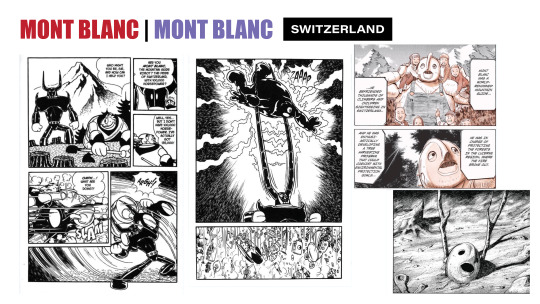
Mont Blanc died first in “The Greatest Robot on Earth”, and in Pluto he fares no differently. Of course, in true dramatic Urasawa fashion, Pluto chooses to begin with the fiery discovery of Mont Blanc’s head tucked within his killer’s calling card to establish the mystery and suspense of this work rather than start with a quaint lumberjacking-scene-turned-robot-fight like the original.
Urasawa and Nagasaki’s choice to include human victims in Pluto also immediately raises the stakes in a way that “The Greatest Robot on Earth” never did or would. It also immediately changes the type of exploration within the world that the series would do, given that the robots of the extended Astro Boy universe are believed to follow Asimov’s Laws.
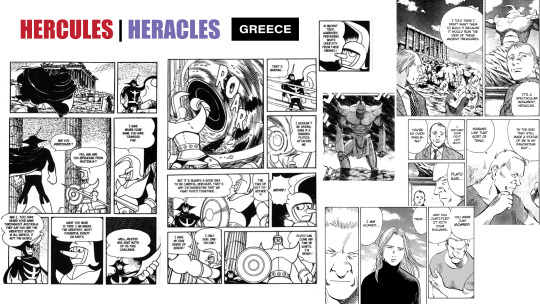
Greece’s Hercules, spelled Heracles in Pluto’s English translation, is a straightforward warrior-type in “The Greatest Robot on Earth”, and he sasses the crap out of Epsilon when he shows up to speak with him just as he does in Pluto. He then gets trounced by Pluto after a drawn-out fight.
In Pluto, Hercules still fits the original warrior archetype, but with the addition of his very own character arc! His rivalry and friendship with Brando is new and refreshing, and his blooming respect for Epsilon pairs nicely with his own discovery of his humanity and personal beliefs as it relates to combat, war, and victory.
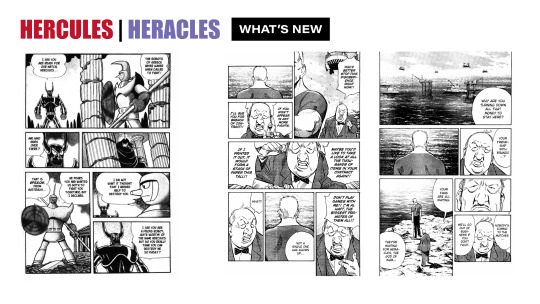
They called him the god of victory, after all, not necessarily bloodshed. He may have lost his fight with Pluto, but he went down believing he won and with a newfound appreciation for life and the bravery it requires to not fight. His manager Al Haft(a) is an easter egg character.
In real life, Greece participated in the Gulf War, but disagreed with the 2003 Iraq War and did not participate. Meanwhile, Australia participated with the goal of growing closer to the USA. In Pluto, these stances were swapped in their representative robots.
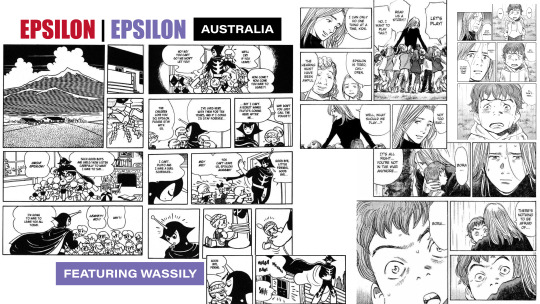
Personally, I think Epsilon (sometimes called Photar in the Astro Boy anime adaptation dubs) is the most surprising figure in these page comparisons if only because he didn’t actually change that much between works. Instead, it is Wassily who exploded onto the Pluto scene with his very own expanded story and Bora trauma. Yes, the disembodied hands scene is in both.

Pluto’s Epsilon looks just like Monster’s Johan, which is funny—Urasawa seems to use Tezuka’s Star System method across his works. In English, Johan and Epsilon are voiced by the same guy, too.

Speaking of, Bora is native to “The Greatest Robot on Earth”, and he is still a bomb. In “The Greatest Robot on Earth”, his creator takes the time to tell the sultan that he created him just to beat Pluto and, by extension, the sultan. In Pluto, Bora’s existence and purpose is to exact vengeance on a broader scale.

Uran’s changes between series are actually really straightforward. In the postscript of the physical Pluto manga’s volume 6, essayist and critic Gorot Yamada laments the fact that Urasawa avoided the “ero-kawaii” of Uran confronting Pluto in nothing but Atom’s briefs and calls it a “minor weakness” since it is representative of Urasawa’s relatively gentler hand in showing “cruelty or eroticism” when compared to Tezuka.
I can’t begin to tell you how funny I think this criticism is, although I do believe that Urasawa does have, overall, gentler sensibilities than Tezuka. But still. I don’t think we’re missing much by keeping Uran in her clothes. She’s still a snot, she’s still a braggart, she’s still good-hearted, and she still makes her big brother look like a square and a stick-in-the-mud. Writing precocious little girls and sweet stories of unlikely bonding moments are a few of Urasawa’s specialties, so I don’t find it surprising that he took the Uran by the hair-horns and maximized her existing character traits.
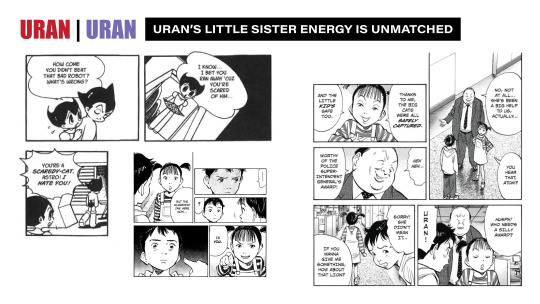
Spiritually, she feels consistent to me, though her basic actions are decidedly different: Pluto’s Uran doesn’t fight or try to fight Pluto, doesn’t want Atom to fight Pluto at any point, doesn’t ever hate Pluto, and has empathy-based powers (separate from that, she may just be smarter and more emotionally intelligent than the original Uran).

However, the sequences in the park and the underpasses where she befriends Pluto strongly resemble Uran’s near-naked adventures in the streets of “The Greatest Robot on Earth”, and that’s fun.
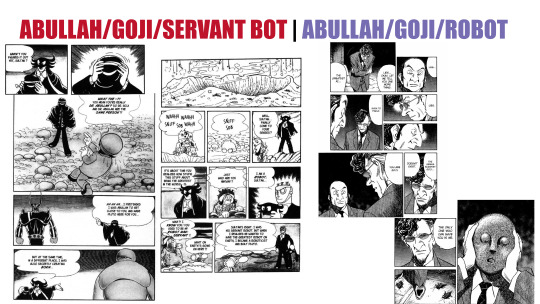
Abullah is where things get spicy, and that’s mostly because the only real change to his character was the addition of his human backstory and discovery of hatred. In Pluto, he is Tenma and Abullah’s science project who believes he is a human scientist (which he isn’t), but he’s actually also got a split personality! That’s a lot. There’s just so much going on with that. But still, where Pluto’s twist falls on the scale of wild twist bullshittery lessens considerably once you know how this character is portrayed in the original, I feel.
In “The Greatest Robot on Earth”, Abullah is a robot butler disguised as a scientist disguised as another scientist. Not to pooh-pooh the original’s Scooby-Doo antics, but, by comparison, Pluto’s reveal is actually quite nice, logical, and thematically consistent. It also gives Tenma a chance to look cool and not just pathetic.
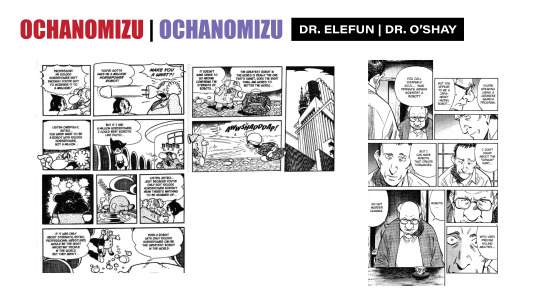
Professor Ochanomizu is the best character. Don’t argue with me. In Astro Boy, he has a big heart and a big temper to match, and he gets knocked around more than Wile E. Coyote in a Looney Tunes segment. He spends most of “The Greatest Robot on Earth” being kidnapped and hanging out with the sultan, but Pluto spreads the wealth by letting the other roboticists be the damsel in distress throughout the plot.
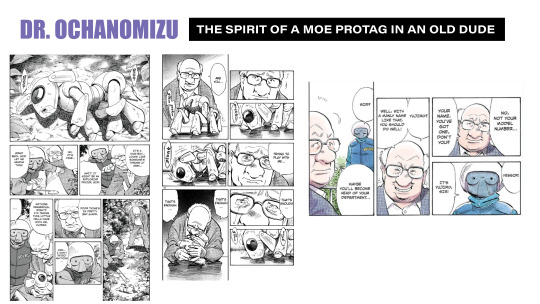
In Pluto, he’s mostly characterized by doing kindly old man shit (do you recognize that robot dog and how it definitely influenced Ochanomizu’s design for Bobby?), but it is absolutely the kind of stuff the original Hiroshi Ochanomizu would do. He gets treated with more on-screen respect in Pluto than in Astro Boy, but only because he isn’t as cartoony. The animation team made damn sure to have the physics of his stomach work not like those of an innocent-at-heart anime girl’s titties when he’s enthusiastically running to the next big important thing, and that’s exactly the right spirit for a creator to have towards this character. A+ job, M2.
Also, in the manga only, Ochanomizu is the facilitator for the single most entertaining referential gag in all of Urasawa’s works: the police dog car diagram. This was cut in the anime.
In the postscript of Pluto: UrasawaXTezuka volume 5, manga critic and lecturer Tomohiko Murakami observes that “Urasawa’s depictions of Professor Tenma and Professor Ochanomizu almost appear to be [his] perspective on two different aspects of Osamu Tezuka’s character.” I don’t necessarily disagree, especially given the commentary Tezuka gave regarding Atom’s status as a “monster”, but I think that Ochanomizu and Tenma also more generally represent the “dark” and “light” side of progress and science. This is likely what Tezuka intended for them, too, back when he was writing the series.
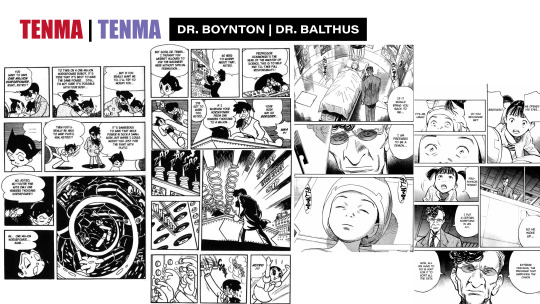
But Tenma is just a hot mess. For the duration of “The Greatest Robot on Earth”, he was more or less emotionally stable up until the “death” of Atom (and guess what? He totally enabled Atom’s increase in strength to 1,000,000, despite Ochanomizu constantly advising Atom not to do), though his general moodiness and instability is a defining character trait for much of the series. He gets better over time, but make no mistake: he is an eccentric, reclusive, and vain disaster man.
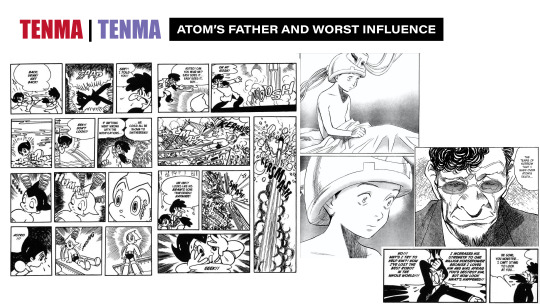
In Pluto, Urasawa lets Tenma’s disaster qualities shine alongside his signature ego, moodiness, cynicism, and destructive tendencies. This man self-sabotages like it’s his job. He also flings his creations around willy-nilly and never thinks about the consequences, and that’s why he has a hand in a significant number of the most harmful and destructive events in the extended Astro Boy universe somehow, including in Pluto.
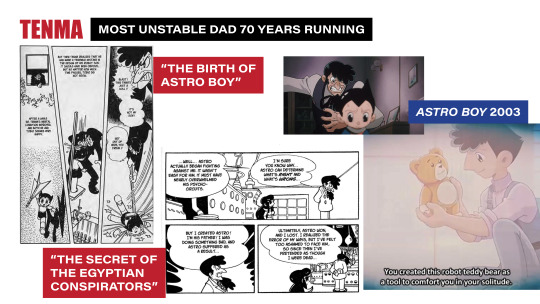
Tenma’s rejection of Atom at the dinner table in Pluto is way classier than his breakdowns in the original Astro Boy manga, but I liked the gravitas of the scene and the over-the-top vibe of the fancy dinner in the sunset. Tenma’s portrayals throughout different series run the gamut from “frenetic cartoon maniac” to “vanilla un-stellar dad” to “Phantom of the Opera”, and this is a nice lean towards the latter end of the scale.

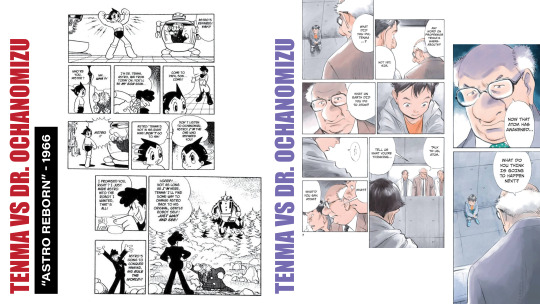
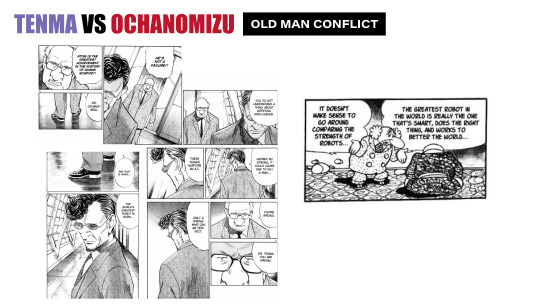
His constant contest over ownership of Atom/influence over Atom with the Ministry of Science (and specifically one Hiroshi Ochanomizu) extends beyond “The Greatest Robot on Earth”, though, and I think elements of their more direct conflicts are very present throughout Pluto. I love an old man fight, and it seems Urasawa does, too.
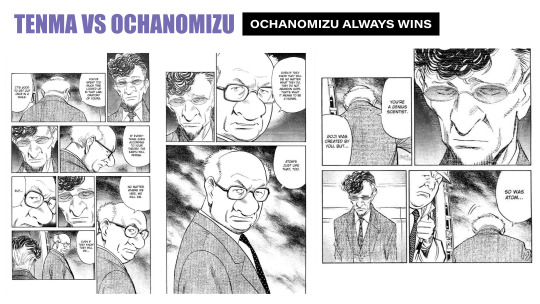
But goddamn is it satisfying to see Ochanomizu tell Tenma to shove it where the sun don’t shine.

Apparently, their dynamic is so popular that it inspired a completely new series set in the alternate universe where they not only go to college together, but are best friends. If you want something fluffier than Pluto where the old men aren’t old, go read Atom: The Beginning, I guess.
And, like, sure. This is all great. But sans the extended old man drama, many of these side-by-sides have been pretty faithful to “The Greatest Robot on Earth”, and that is NOT what Makoto Tezka asked for.
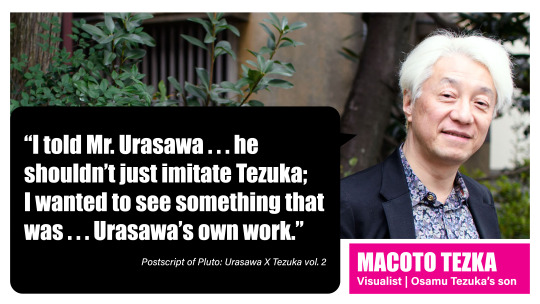
Pluto as a Remix of Astro Boy
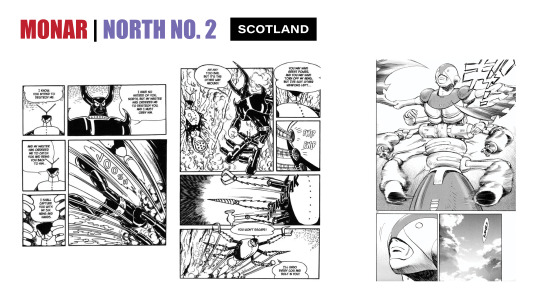
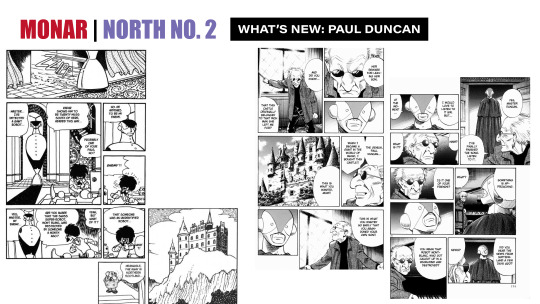
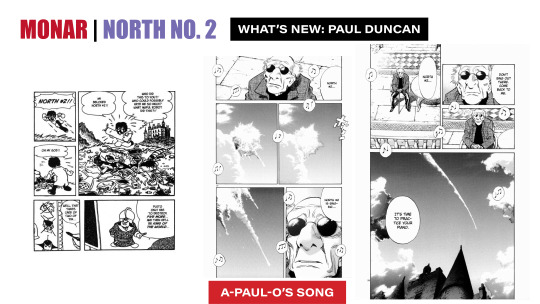
North No. 2, called Monar in “The Greatest Robot on Earth”, is generally the same robot as in his original portrayal, but instead of just going to fight Pluto, he stars alongside new character Paul Duncan in a brand new story about pianos and music and being blind and growing past trauma to accept others into the heart. Tezuka’s Kuroo Hazama (Black Jack) was even there in Paul Duncan’s memories. It had everything: crying old people and kids, medical drama, orphan trauma, mama trauma, prostitution implications, castles, the emptiness of fame and fortune, singing, an android dreaming of more than just electric sheep, long monologues, and an emotional goodbye where one character stares longingly (even if he can’t actually see anything) at the other knowing they shall never return.
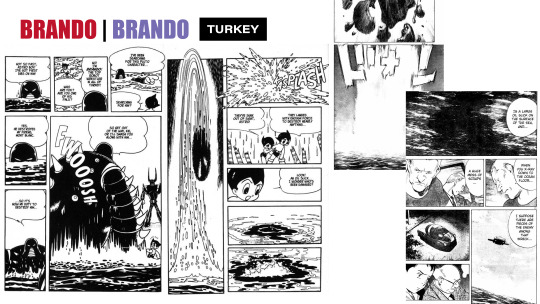
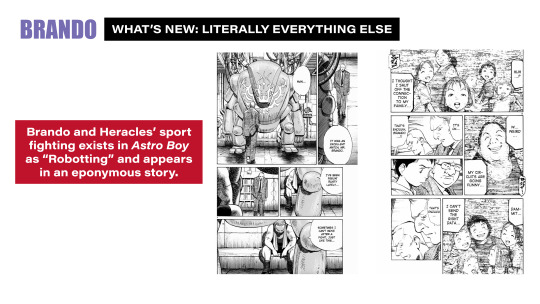
I’ll just say it: Turkey’s Brando is a total red shirt in “The Greatest Robot on Earth”. Meanwhile, Urasawa gave him a family, a love of Turkish drinking culture, a friendship and rivalry with Hercules, and a penchant to dabble in illogical forces like luck, and a classic tearjerker death. Urasawa gave him the world.
In the anime, Brando is among my favorites. Y’all can swoon over your twink Epsilon or whatever, but it’s Brando over randos for me!

Chochi Chochi Ababa transformed into Saddam Hussein—er, Pluto’s King Darius XIV. One is a cartoon villain who provides an opportunity to learn a basic moral lesson, and the other is a motherfucking war criminal. I think that's a sufficiently mature new twist on an old concept.
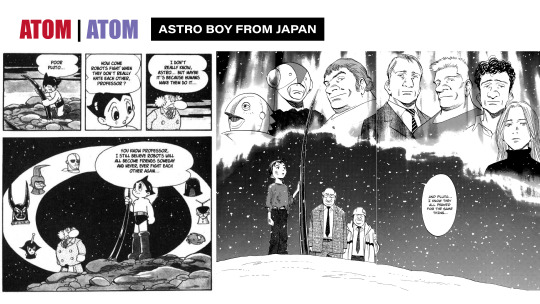
Of all the characters present in Pluto, Atom himself is likely the one that gave Urasawa and Nagasaki the most grief, if only because he is the one and only Astro Boy, hero of justice, and if his portrayal wasn’t popular, they’d probably be sent to manga hell forever.
For me personally, one of the most gratifying details regarding his portrayal is how quickly he will lie while maintaining the lie that robots can’t and don’t lie. This line of thinking, as well as the implication that Atom follows Asimov’s Laws more because he wants to, not because he has to follow his programming, is something that became more and more apparent the longer the original Astro Boy ran even if none of the other characters directly said anything about it. Speaking as a fan, I also think it’s nice that Urasawa makes the most of upholding Atom’s observed personality traits throughout adaptations. That he made Atom a deeply curative flavor of an insect kid is a grounded, but nice touch.
(It may also be worth noting that Osamu Tezuka had a known fascination with insects. The “Mushi” in Mushi Productions means “insect”. I don’t know how intentional that was, but it seems Pluto’s Atom may have been intended as a chip off the ol’ Tezuka block whether he was his “monster” or not.)
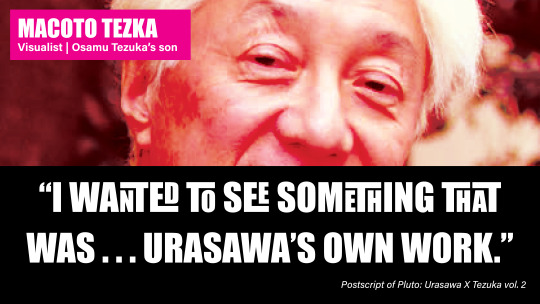
But as lovely and detailed as Urasawa’s embellishments on these characters is, this is still not what Makoto Tezka asked of him. So far, these characters are strikingly similar to the existing “The Greatest Robot on Earth”, and apparently, if Tezka’s interview in the postscript of Pluto: UrasawaXTezuka volume 2 is to be believed, he told Urasawa multiple times to keep revising until he made it his own! It seems Atom really became Urasawa’s monster, too!
#astro boy#pluto#naoki urasawa's pluto#netflix pluto#naoki urasawa#hiroshi ochanomizu#osamu tezuka#umataro tenma#epsilon#brando pluto#hercules pluto#epsilon pluto#tetsuwan atom#astro#uran#sifl's meta presentations#Pluto presentation
66 notes
·
View notes
Text
Is Eric Kripke America’s Tolkien?
So I started Supernatural for the first time around 6 months ago for which I blame Tumblr entirely (where do I claim compensation?). In fact it’s very good and fun and I can’t believe I missed it when it was live.
Ok so bear with me I’ve been sick for a few days a combination of high temperature plus rings of power trailer drop may be making me delusional, but I got to thinking … why did this show have such a hold not just on this site, but also on so many fan artists and fan fic writers. (I mean it has a strangle hold on Ao3)?
Then the RoP trailer dropped and I got to thinking is it because it world builds from a US stand point like Tolkien world built from a European standpoint?
Then because I am sick and can’t sleep I am sharing my stream of consciousness o: Kripke as Tolkien, Sam as Sam, John Winchester as Gandalf, Castiel as Beleg and Dean as Turin Turambar - and maybe now I’ve got this out of my head I’ll feel better….:
I attempted to put this under a cut so hope it worked!
:readmore:
Source material
Most modern fantasy stands on the shoulders of JRR Tolkien who basically ingested a ton of European myths and languages (with focus on Northern Europe) and spat out the middle earth legendarium.
Eric Kripke (plus writing team) seems to have ingested a ton of US urban myths and US pop culture and spat out “Supernatural-verse”. Because it is *US myth making* it is distinct from a lot of other US writing that builds off Tolkien and / or European myth arcs (I’m looking at you Star Wars, Westeros etc).
And the themes and sensibilities therefore pulled out by Kripke are *not* the same as Tolkien’s themes and sensibilities. This makes it different to a lot of modern genre fiction (in whatever form) that either builds on or seeks to subvert the themes in Tolkien’s work.
(There’s also a lot of genre fiction that is satire or allegory for the real world, but that is another category to me and not really world building in the same way - incidentally the Boys fits into that category along with Good Omens).
Both ofc back end off the Bible but this is English literature based story telling and no one escapes the Bible or the bard.
Structure
We usually think of Tolkien in terms of:
(1) Hobbit - entry level nicely structured “there and back again” story for children, darker than expected. Main hero arc -Bilbo.
(2) Lord of the Rings - the pretty perfect fantasy master piece - very accessible clear meaningful themes and tidy /satisfactory ending. A number of hero arcs, but clearest drawn are Frodo / Sam.
(3) Silmarillion (&etc) - this is where the legendarium really gets built. It’s not neat, it’s not accessible, some of it is *not* a good read but the ideas here build the world. We have a creation myth. The “good” “wise” guys turn out to be more complex and flawed than we thought. The evil guys are extremely toxic but entertaining and bring the drama. There are epic doomed romances between immortal beings and mortal beings. Everyone messes up and makes catastrophic world destroying errors on the regular. People get cursed and can’t escape their doom. I can’t think of any real traditional hero arcs (maybe Beren or Luthien??). Note Tolkien didn’t finish this and it’s put together by someone else.
Now let’s do Supernatural
(1) seasons 1-3 - Horror procedural-
Entry level solid procedural hunting / horror story. Sam W is here in the traditional hero role. Dean is like your Thorin initiating the adventure. John Winchester is in the Gandalf role (he knows what’s going on and holds the secrets but is not available to the adventurers at all times). Maybe there something deeper and darker going on? This is your Hobbit equivalent very accessible but not particularly unique.
(2) season 4-5 - myth arc - lots of fans will say this is the perfect part of the story and a masterpiece of genre writing. It’s neat with clear meaningful themes and a tidy satisfactory ending. A number of hero arcs though Sam’s remains the most clearly drawn. Dean is more like your Aragorn or Faramir at the end of 5, Bobby in the mold of a Theoden and a Castiel in sort of Gandalf type position. Baby ofc is Shadowfax. This is your LoTR equivalent
(3) seasons 6 - 15 - the Legendarium- this gets a lot of criticism but it’s where the legendarium really gets built. It’s not neat, it’s not that accessible, some of it is not great to watch, but the ideas here build the world out. We have a creation myth (hello Chuck & Amara). We have hero doomed by the narrative (most notably Dean Winchester, though also Castiel). We have epic love stories between mortals and immortals. Yes I am comparing Dean & Cas to Beren & Luthien (!) though Turin & Beleg would perhaps be more appropriate (there’s a good case for Dean = Turin in this universe). The good guys turn out to be more complex or darker than we thought. The evil guys are extremely toxic but entertaining and bring the drama.
There aren’t really any straightforward hero arcs which is one of the reasons Sam fades out a bit and Dean comes forwards as a character. The stories are messy and tragic.
Landscape
Middle Earth - if you read the books or watch the movies or show it’s clear that Tolkien’s (sub)creation is a love letter to the mountains, lakes and woods of England and Europe. It’s also a cry of anguish for their destruction. Both the beauty and destruction are heightened (Europe doesn’t really look like this and really never did - as for the movies they were shot in anew Zealand and then digitally enhanced…) This is as important as the characters and plot - and stands out in particular in the Hobbit and LoTR where there are long descriptions of landscapes (or long shots of the same in movies / shows).
“Middle Americana” - it’s clear that as much importance was put into the look of the landscapes in Supernatural as to the characters or story. In this verse the look is long open roads, beautiful mountains and big skies that are a declaration of love for America, and the run down small towns seem to present wistful sadness. But again it’s not real it’s heightened. The cinematography in first few seasons is particularly thoughtful (and perhaps Kim Manners is to be thanked for that). The show is shot in Canada and the motels / gas stations in middle of no where needed to be built because they didn’t exist in reality. Again the landscape - the open road, the small towns, the big sky, the motels / dinners / gas stations in the middle of nowhere are as much a character as anything else.
I could go on but I suppose if anyone read this far you get the point (and more importantly it’s now out of my head and I can think about something else!).
Ultimately it will take some time to see if this could be right - in terms of genre fiction Tolkien is everywhere and you can’t escape it (even if you never read or watched any Tolkien!). Time will tell if the Kripke verse has the same impact on creatives and audiences, but I just look at the A03 archive and notice how many people know what happened on Supernatural without ever watching it (!) and think hmmm these are the readers and writers of tomorrow after all.
#rings of power#trop meta#rop meta#supernatural#supernatural meta#tolkien#eric kripke#lord of the rings#silmarillion#kripke era#dean winchester#sam winchester#the hobbit#castiel#turin turambar
55 notes
·
View notes
Note
Haii Kooki!! First, i want to say that I love your theories, fanfic and yt videos!!
I came to ask what do you think about the possibility of Ralsei being a titan, if you think it's possible in any way?
Thank you if you see this!! Have a good day/night ✨💕
Hi, thank you for the compliments, and I hope you have a great day, too!
The idea that Ralsei could be a titan (the big one with horns specifically) was actually something my friend Shadowhaxor (@downlowbroyouknow) proposed on a server we're both in, and it kind of stuck with me since. I'm not sure if I fully buy into it yet (as there's no evidence for OR against it so there's no real arguing on the topic) but the symbology surrounding that idea just feels so specific to me that I think it might be intentional.
"The evil within" and "I choose to help when I was made to destroy" could be REALLY interesting roads to take Ralsei's character, and "your actions DO have consequences" being revealed through Ralsei turning into a titan himself would be a hell of a gut-punch and a really effective way to subvert the "your choices don't matter" beginning statement of the game. PLUS with Ralsei's inconsistent design choices there's really no telling if the resemblance to the largest titan is far fetched and impossible, or uncanny and undeniable - it can really swing both ways depending on which of Ralsei's sprites you're looking at, and I think that adds to the overall vibe of this "theory" as it adds potential layers to Ralsei's existence and identity that we wouldn't have otherwise.
He's both mysterious and malleable, he's well-meaning but not incapable of causing harm, and he was made for the prophecy but that doesn't mean he can't embody its ugliest side as well.
(I think there's also something between "The Legend" and "The Dark Truth" that feels like we're missing a piece between them, almost a missing link between the two songs that tells us the full story when we put them all together, but I'm not musically literate enough to expand on that idea.)
Again, as things stand right now I don't think this is 100% canon (no evidence = no concrete conclusion), but there's a lot of imagery and symbolism here that makes me feel like its justified to speculate about, especially knowing how neatly it could fit into Deltarune's overall narrative.
#deltarune#asks#deltarune chapter 2#deltarune thoughts#deltarune theory#ralsei#ralsei deltarune#deltarune titans#utdr#once again shoutout to shadowhaxor he introduced me to the idea first and its been part of my brainrot since#rambles
24 notes
·
View notes
Text
Blake Belladonna's Design
This is a quick appreciation of our Cat Girl's design. Its objective is to offer a short analysis by incorporating elements of other metas. Ideally, the end result will be something similar to Yang's post. Finally, this is the final piece of my mid-summer Blake meta spree :) So, enjoy!
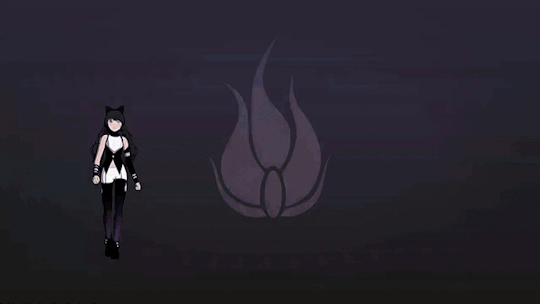
JUST ANOTHER CAT GIRL?
Blake's design plays with the idea of "cat girl". Cat girls are common in anime and mangas, but are often overly sexualized. In particular, cat ears are usually presented as an overly cute trait and sometimes a fetish.
RWBY takes this idea and subverts it in 2 ways.
Blake's ears are initially hidden, so that her affinity with cats gets highlighted through other aesthetical elements:
Gambol Shroud's ribbon resembles a cat's tail and it being a whip may reference the infamous cat o' nine tails
She decorates her eyes with cat eye makeup
She is able to make copies of herself, which get jokingly referred to as copycats
In Mistral she wears leg boots, which bring to mind Puss in Boots
In Atlas she wears a catsuit
Blake's cat trait becomes a core part of her identity, which is explored on a double level:
It represents her faunus heritage, which makes her different from humans and discriminated
It is a symbol of Blake's troubled past and of her involvement with the White Fang
So, Blake covers her cat ears to run from both society and herself. Just like a scaredy cat ;)
As you see, with some limitations and worldbuilding, Blake manages to be a cat girl with much depth to her. Still, there is more to her cat design.
FROM CALICO TO TUXEDO
Let's juxtapose Blake's initial concept art with her final design:


What changes is the cat used as the main inspiration.
In the initial concept art it is the calico cat (tricolor cat):
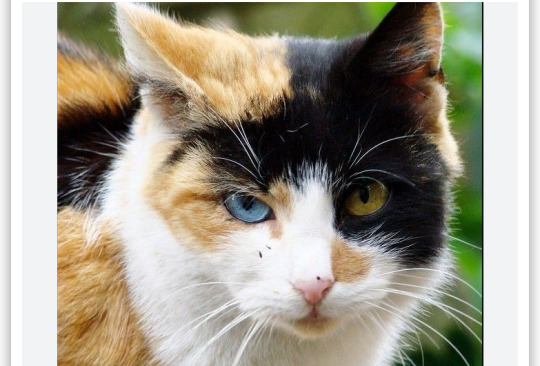
In the final character design it is the tuxedo cat (bicolor cat):
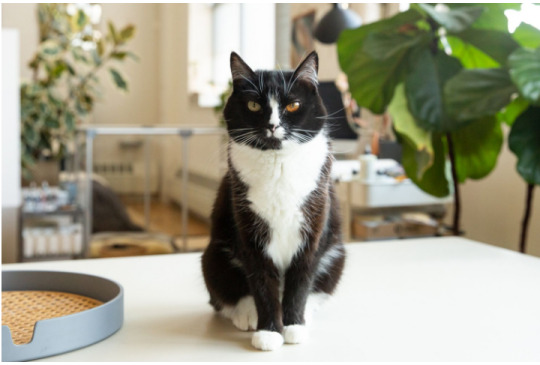
Why the change? Let's explain it by highlighting one similarity (1) and one difference (2) between the two kitties.
1- Both cats are called after a type of cloth:
Calico is a fabric, which originates in India (the set of the Jungle Book - Blake's secondary allusion) and is famous for its colorful printed patterns. I wouldn't be surprised if Blake's clothes in the concept art were meant to be calico made.
Tuxedo is a formal wear, which consists of a black suit over a white shirt and a bow tie. Well, Blake's final design is a revisitation of the traditional tuxedo with a shorter jacket and a bow worn in the hair, instead than as a tie.
The idea of "cloth" is heavily used in Blake's design, which may be one of the reasons why the tuxedo is eventually chosen. This kitty, thus, offers a pretty poignant metaphor.
It all starts with Gambol Shroud, where shroud means a piece of cloth that conceals or protects:
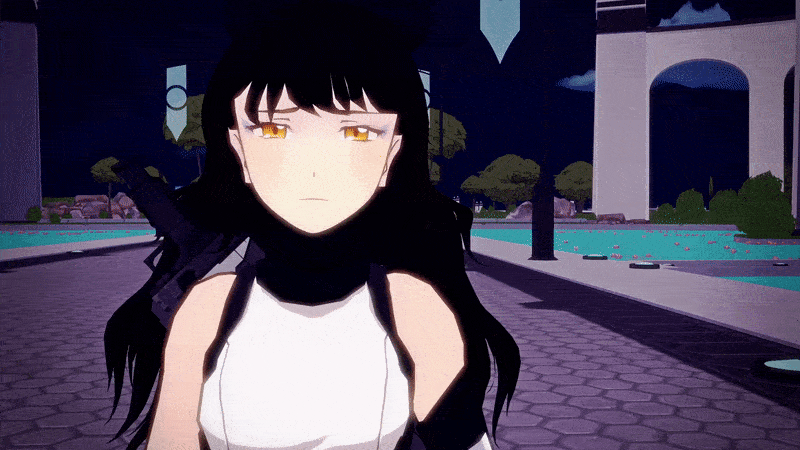
Here come two thoughts:
Blake's bow is her shroud which is why it resembles her weapon’s ribbon (same color and similar material). The bow is the ears, while the ribbon is the tail. Together they complement Blake’s cat design.
Some tuxedo cats are called tuxedo masks because it is as if a black mask covers their whole faces. It is easy to see how this concept fits Blake, who conceals herself thanks to a little piece of fabric.
Basically, Blakes's bow is her tuxedo tie, which is worn as a mask.
2- The two cats differ when it comes to their color:
The calico is a tricolor cat, which is mostly known as having a white coat with some orange and black patches
The tuxedo is a bicolor cat, which has white and black fur
These two color patterns are another reason why Blake has been characterized as a tuxedo instead than a calico. As a matter of fact the black and white dychotomy fits our beautiful faunus girl more.
WHITE AND BLACK = BEAUTY AND BEAST
In old English, Blake's name means both black and white. As a result, she is linked to both colors, which tie with her light and shadow motif:

Blake is associated to the twilight because it is where light and shadow meet. What's more, her musical theme is built on this duality. She starts in the shadows and climbs her way up towards the light.
Well, Light and Shadow are linked to two Jungian Archetypes:
The Light is the persona, so what is shown to others
The Shadow is what is repressed, so the hidden parts
And these two archetypes are explored in The Beauty and The Beast:
The Beauty is the light - she is beautiful, lovable and accepted
The Beast is the shadow - he is ferocious, scary and misunderstood
So, Blake's own allusion can be read as the integration of beauty and beast, light and shadow, so that a new unit (a new individual) is born. This is also Blake's arc in a nutshell. She starts as a shadow because she hides herself, but with time she steps into the light and shows the world who she is.
In other words, Blake's Beauty and Beast allusion is referenced in her appearence not only in her nature as a faunus, but in her color scheme too. She is both beauty and beast, light and shadow, white and black.
This is also why these two colors are incorporated in respectively Sun and Ilia.
Sun is white, as he leads Blake towards the light:
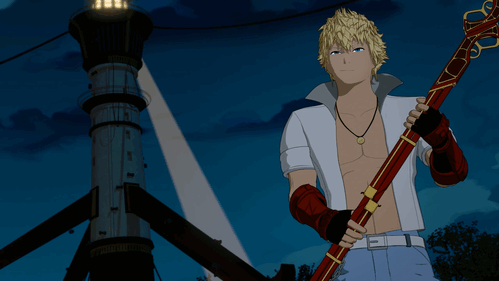
Ilia is black, as she forces Blake to face her own shadows:

Through them Blake integrates her shadows and stops hiding:

This is why her design changes in Mistral in two notables ways:
She gives up her bow once and for all
She wears a white jacket over a black top
These two details mirror Blake's inner journey. She learns to show herself more, so her ears get to be out in the open and the light (white) surfaces. In Beacon, instead, the ears are concealed and Blake is wrapped in shadows (black).
Ironically, this means Blake's design loses the core traits of her tuxedo cat inspiration. As a matter of fact she has no bow tie anymore and the color pattern is inverted, which doesn't work. Why this choice? It is because Blake is going from Beast (black + cat) to Beauty (white + individual). Symbolically, this happens as she shows her faunus trait more openly:

She grows more beautiful (human) as she openly embraces her beast side (cat).
GOLD, BLUE AND PURPLE = HOT, COLD AND JUST RIGHT
The shift from calico to tuxedo brings some consequences to Blake and Yang's complementary designs.
Let's compare the bees exploratory ideas:


As people have noticed, Blake and Yang are aesthetically and symbolically linked since early on.
Here, we have:
Blake with one gold eye and one blue eye
Yang with a blue bandana
This chromatic choice ties into Yang's allusion and design. As a matter of fact our Goldilocks uses colors to represent the too hot, too cold and just right. Specifically:
red/orange is the too hot
blue/green is the too cold
purple (blue + red) is the just right
So, in the picture above Yang's looks play with the dychotomy between too hot and too cold. This same duality is mirrored in Blake:
She is both too hot (gold eye) and too cold (blue eye)
She wears much gold in general (Yang's main color)
The idea is clear. Blake is Yang's hot and cold. In particular, she brings some needed blue in Yang's life. She helps Goldilocks cool down and become more balanced. Similarly, Blake proudly wears Yang's golden tones, as she has to grow more like her Golden Beauty.
So, how have these ideas evolved in Blake’s final design?
Blake has gained a strong association with purple, which makes her Yang's just right
Blake's color scheme has ditched gold in favor of silver, which makes her and Yang complementary
Blake's link to purple is interesting because this color calls back to her family and to the surname Belladonna (beautiful woman in Italian). In other words, it is connected to both Ghira's legacy and her Beauty side. So, it is not a surprise that Blake grows more purple in each arc:

She is slowly blooming into Yang's just right by reconciling with her legacy and by becoming a person worthy of our golden girl.
This transformation is highlighted also by Blake integrating some gold into her:

In both her Vale and Atlas's designs Blake is linked to silver, so that she can complete Yang's gold. Still, in Mistral she has some gold details because this is the arc where she integrates her missing parts. This integration ends with Adam's death and Blake's rebirth:

So, Blake's design tells a story of inner growth, which leads her to stand beside Yang as an equal:
Blake: She's not protecting me, Adam. And I'm not protecting her. We're protecting each other.
This theme is important for Blake's Cat Girl archetype. Cat Girls, thus, are often reduced to love interests, but Blake's arc is a deconstruction of this idea. What would happen if the male partner of a Cat Girl is abusive? Blake explores this concept and tells a story of liberation and development, which ends with a reconstruction of the trope. Our Cat Girl ends up in a happy relationship, but not as a shallow prize. Rather as a winner.
BEASTS, LIONS AND WOLVES
In conclusion, Blake's design alludes to the Beauty and Beast on three levels:
Society= Blake is both human (beauty) and animal (beast)
Couple = Blake and Yang are drawn as complementary
Individual = Blake is both white (light) and black (shadow)
Still, this is not the only fairy tale our Cat Girl ties into thanks to her animal features. Here come three examples.
Blake is Bagheera's daughter and a small panther (a cat) in the Jungle Book
Blake is a Scaredy Cat to Lioneheart's Cowardly Lion. Except that of course the cat is braver than the lion
Blake is Ruby's black beast in team RWBY's LRRH team allusion
This last reference is foreshadowed since Red Like Roses:

Black the beast descends from shadows.
After all, the Beowolves appear when Blake's line comes up.
Moreover, Blake's secondary allusions all come together to strongly link our Black Shadow to wolves. In the Jungle Book, Mowgli is raised by wolves, just like Blake grows up in the White Fang. The name of the group itself calls back to wolves, as it references the title of Jack London's book about a half-dog half-wolf, who fights to be accepted by humans.
Finally, it turns out Blake is not the only Cat, who turns out to be a Wolf:

In short, Blake's design lets her freely move between allusions and references. Not only that, but it is crafted to add depth and thematic resonance to her character and her arc. Not bad for just another Cat Girl, uh?
#rwby#blake belladonna#rwby meta#my meta#yang xiaolong#bumbleby#character design#once upon an allusion
213 notes
·
View notes
Text
i saw a screenshot reposted on twitter of a j0nsa explaining how to find j0nsa “foreshadowing” and genuinely at first i thought it was a parody of how some j0nsas post on here because it was so …💀
i’m not sharing the screenshot here bc no one deserves harassment or to feel bullied for what they ship. however, seeing that post helped crystallize a long-held observation of mine about a ship that i do not like yet cannot fully avoid due to the fact that it is one of the biggest in the fandom and it involves one of my favorite characters. no hate no shade to my j0nsa mutuals, my filters and i love you for tagging your posts (and also for not posting weird murder fantasies about dany!).
because j0nsa is so popular, it can set the tone for discussions about sansa on here. often times that tone comes across … god how do i say this nicely … weirdly gender essentialist. this is an observation that i’ve struggled to articulate for a while but the post in question inadvertently helped me put my finger on the reason why i am so put off by these theories (and the ship in general if i’m honest).
basically, the post claims that there is a pattern of opposite-sex characters around jon and sansa that have the traits of the other. jon and sansa are both kind of the traditional fantasy hero/heroine ideals so like … of course sansa is going to encounter men who are conventionally masculine in the same way that jon is and of course jon is going to encounter women who are conventionally feminine in the way that sansa is. and of course they'll meet people who aren't that feminine/masculine ideal. the post also says that it can still be j0nsa foreshadowing if the person in question had “opposite” traits from jon or sansa — apparently jon thinking about arya means he’s actually thinking about sansa? uh… i think you just made up circular logic so that you can claim every woman jon interacts with or thinks about is a sansa stand in and vis-versa!
in the actual text, meanwhile, jon finds himself drawn to warrior women like ygritte. in a way, sansa is too – she seems to have a fascination with mya stone. an actual parallel between jon and sansa is the fact that they each have a fascination with a dark-haired androgynous bastard of their same sex that they call pretty in their respective remote snowy locations (satin and mya). they also both remark on the beauty of the lannister twins — only, jon remarks on jaime’s beauty and sansa remarks on cersei’s beauty.
now, these examples are some of the reasons why i personally read jon and sansa as characters who are likely queer in some capacity. frankly a lot of sansa’s thoughts remind me of myself as a closeted preteen. because i read both characters as not straight, however, i find it especially restrictive when the conversation around these characters is reduced to how well they fit their masculine/feminine ideals and why that means they must be soulmates. it doesn't give them room to defy the gender ideals that define them in some fans' minds. in a series about subverting conventional tropes in fantasy, i just don’t believe that the feminine ideal girl and the masculine ideal boy are going to ride off into the sunset together.
yet, you could use the same passages from the text to say that jon and sansa’s admiration of cersei and jaime means that they’ll also do sibling incest (i don’t care that they’re cousins by blood, they were raised as siblings). jon comments on the fact that jaime looks the way a king should and sansa looks up to cersei because she wants to be queen one day – again, you could also use this to argue jon will be king and sansa will be queen. i mean, i would disagree with you, but it still makes a hell of a lot more sense than reducing every woman jon interacts with into a sansa stand-in and reducing every man sansa interacts with to a jon stand-in.
#anti jonsa#sansa stark#asoiaf fandom meta#could also be deemed#asoiaf fandom wank#queer asoiaf#jon snow
22 notes
·
View notes
Text
macbeth related posts/articles/essays masterlist
hi! here's a list of almost every single anaysis Thing I've come across in like two months of being insane about the scottish play. Most are about lady macbeth/the gender theme btw.
‘He has no children’: The centring of grief in The Show Must Go Online’s Macbeth - Gemma Allred: on the misogyny that frequently surrounds conversations around Lady Macbeth
this post by @amillionmillionvoices: Same topic as the previous one, but goes more in depth, explains ladymac’s motivations as mostly coming from love not self-serving ambition.
this post by @dukeofbookingham: also explains the prior point very prettily— that ladymac is (mostly) motivated by love, but also makes the case that many of it is guilt born from not fulfilling societal expectations
On the character of Lady Macbeth - Dr. Emil Pfundheler: paper that explains the same point made in the previous post, using the text to explain. Written in 1873 so explains gender as a dichotomy, but once you take that out, its points are very good.
Characteristics of women: moral, political, and historical - Anna Jameson: aka Why Lady Macbeth is not inherently evil— same topic and the other two, but focuses a bit on the fact that she is A Woman. Not my favorite, but worth reading I suppose. Also includes analyses of many female Shakespeare characters. It does include some very bad history in the beginning— Gruoch did not orchestrate Duncan’s murder. That’s something Hector Boece made up.
Lady Macbeth: “Infirm of purpose” (from The Woman’s Part: Feminist Criticism of Shakespeare) - Joan Larsen Klein: on how she both fits and doesn’t fit the idea of a reinassance wife— doesn’t fit because she isn’t aligned to god (this read more like a Christian analysis than a feminist one if I’m being honest), but fits them because she behaves like one, only subverts them because she’s like, the evil murder girl version of the Wife. The essay right after this one is also very good.
The Hysteria of Lady Macbeth: required reading if you wanna play her Btw not kidding. Analyzes her character thru the lens of freudian psychology. Screws up the text of the play a bit but provides an actual in-depth explanation of how sonnambulism works. Note that "hysteria" is not a current psychological diagnosis, but a symptom of other conditions. Still extremely interesting.
The Macbeths - G. K. Chesterton: analysis of their relationship, makes some interesting point on the differences of the nature of their ambition and desire to kill the king
Shakespeare’s tragic frontier; the world of his final tragedies - Willard Farnham: this one is long but oh boy does it go deep. Talks about the lore of the witches, explains historical context to find out how the real events were so screwed up, makes an interesting point about Macbeth’s conscience against Lady Macbeth’s, and lastly talks about the tragic world of Macbeth compared to other tragedies.
Women’s fantasy of manhood: a Shakespearean theme - D. W. Harding: exactly what it says on the tin, using ladymac and her skewed (and I’d call romanticized) idea of what a man is that she pushes on Macbeth. So yeah, talks about the gender theme. Also talks about Goneril from Lear, Cleopatra, and Volumnia from Coriolanus and how they fit the theme— although ladymac is the only one who goes downhill from it.
Unnatural women in William Shakespeare’s Macbeth - Elizabeth Klett: I’ll be honest I didn’t love this one a lot. Basically talks about how every woman in Macbeth defies gender roles. Doesn’t go too deep however. But the book has a ton of essays analyzing female characters in classic lit.
#macbeth#shakespeare#william shakespeare#lady macbeth#classic literature#english literature#classic lit#billy shakes#king lear#coriolanus#there u go. the result of 2 months on insanity#i hope this helps someone or that u have fun at least. i did#also if anyone wants to add anything about any of These feel free bc i dont know much about. most of the things discussed
181 notes
·
View notes
Text
ARC REVIEW: This Will Be Fun by E.B. Asher

4.25/5. Releases 9/10/24.
vibes: Shrek (but with some angst and lots of romance), Dungeons & Dragons, second chances all around, "we were doing so good and then reality happened'
Heat level: 5/10
The basics:
The heroic Four--Galwell the Great, his sister Elowen, their childhood friend Beatrice, and mercenary-turned-friend Clare Grandhart--are on the brink of saving the kingdom. And then they do... at the cost of Galwell's life. Ten years later, Elowen, Beatrice, and Clare haven't spoken since the funeral. But now, they're all obligated to attend the queen's wedding. Clare and Beatrice, whose tension-filled bickering turned to loathing after Galwell died, are begrudgingly on the same path. And Elowen is roped into going when the queen hires Vandra, an assassin she had a thing with on the last quest, into bringing her to the wedding. When all four crash into each other--compelled to save the day one more time--they have to deal with allllll the unresolved feelings. Romance! Adventure! Friendship! Pet eagles! YES.
The review:
Dude! This was so fun!
I was a little skeptical about whether or not this would actually be a romance. Short answer: yes it is, and you get two for the price of one. Two second chance romances for the price of one at that, which is always great for someone like me.
I didn't shelve this as a book with a secondary romance because for all intents and purposes, Clare and Beatrice's romance and Vandra and Elowen's romance really get almost equal time. They both have issues, they both have heat, they both have grand love confessions. The only thing that makes Clare and Beatrice a little more prominent is that there are three POVs in this book--Clare, Beatrice, and Elowen. Vandra doesn't have a POV, and while I get that she wasn't a part of the original Four... I would've liked it! She's on the page as much as the other three, and I loved her and her relationship with Elowen.
That quick critique aside: point is, as a romance reader you get a lot of different things, and it's great. You get Vandra cheerfully offering to consensually kidnap the introverted, awkward Elowen, and Elowen being unable to resist because like... Yeah dude. Vandra is just hot like that. You get Clare and Beatrice's unresolved "one night stand turned questmates falling in love turned people who aren't over each other but haven't been able to deal with their feelings ever since the big bad thing happened". Unresolved horniness! Intense feeling! It's all the type of shit a romance reader will gobble up.
However, the world is also a really great part of everything. It's very much fantasy by way of Shrek. Some of our characters speak to "heart healers", who can help them analyze their feelings. One watches "shadow plays", and boy is she into fandom. A heroine who once helped saved the world is kind of a messy bitch fresh off a divorce nowadays.
It's all very tongue in cheek and snarky, but in a very WHOLE FEELINGS way. You can tell these authors fully love this kind of setting, things like The Princess Bride and Dungeons & Dragons. Fondness and emotion is a huge part of the story. So yeah, while there are antics, you never lost that sense of like... cuddly softness. I mean, Clare literally has extended inner monologues about how much he loves his pet eagle. It's the cutest thing.
Often, cuteness is used to dodge a need for plot and character development in recently published romance novels. Here, that's not the case at all. You can tell that a lot of love was put into differentiating these characters, sending up archetypes while also subverting them. These aren't perfect people. They fuck up sometimes. It's actually quite refreshing to me that Beatrice and Elowen in particular are kind of... poorly adjusted ladies in their early thirties who need to work on their shit. Appreciate that representation. But beyond that, survivor's guilt and PTSD somehow fit so nicely into what is ultimately a really funny and really sweet fantasy romance novel? My God, we really can have it all.
I feel like there was a great balance between like... quest plot, relationship plot (both romantic and platonic, no bond is neglected) and funny little sidebars and quotes that had me bookmarking pages for later. Balancing between saving the world, kissing, and a character saving the day by autographing swords kind of creates a great palate-cleansing blend.
The Sex:
You only get two sex scenes in this book, one for each couple, and while they're explicit they're still a light touch in that sense. However, I found both of them sexy, and there's a ton of chemistry and tension in both romances. You get "questmates with benefits" on one side, and "man doggedly pursuing woman who pretends she doesn't give a shit" on the other. We all win.
I loved settling into this world for a romp. You get a strong voice here, great characters, romcom antics, and yeah, a lot of heart. I'd love to read another book in the same world--and hell, I'd love to see a miniseries made out of this one. It's just a really good time without being stakes-less, and that's not always easy to find. Go on the quest, I'd say.
Thanks to NetGalley and Avon for providing me with a copy of this book. All thoughts and opinions are my own.
17 notes
·
View notes
Text
Reflections? (Yesterday's Lie)
The term “holding up a mirror” usually applies to confronting someone with their own actions and pointing out their flaws. Stories like to do this through foils that share enough characteristics to annoy each other, or villains and heroes that are either the best or worst version of each other. It’s a really neat piece of storytelling.
Yesterday’s Lie is this idea in its most blatant form. Luz literally looks into a mirror and argues with her reflection. Its straightforward and simple.
Except this is The Owl House, it’s not capable of playing anything straight.
Let me explain.
SPOILERS AHEAD: (The Owl House, Dead Poet Society, Billy Elliot, Gravity Falls)

One of The Owl House’s core thematic is individuality and the joy of complexity. It is a story about taking life as it is and not putting unfair constraints on it.
This is why the show is so tropey and so averse to tropes at the same time. It makes a beeline for the closest stock structure and then thoroughly dissects and subverts it. It’s a satire, a hunter of cliches.
As a way of hammering that home, everything in the series is introduced twice. Whenever any plot beat or location is revealed, you get a first pass and a shallow look at that thing, and you get an obvious trope that this first appearance fits into, then you spend time with the thing, and you start to understand just how much that first impression was deceiving. This happens to everything, even the show itself.
The series opens with the famous “eat this sucka!” line and a fantasy witch story, priming you to expect generic fantasy, but you are then met with The Owl House, which is anything but.

Hey look, a conspicuously hidden character from a family photo. This is foreshadowing for a later episode. But if you think about it, this filmmaking technique is weird, right? Telling you something is important by now showing you it at all. I don't have anywhere I'm going with this, it's just something quirky about cinematography.
This also happens to the characters, and I go into more detail about it in my post about the first episode, so take a look at that if it interests you. But there was one notable exception to the rule. Camila Noceda.

When we first see Camila, she is the distant parent, the stock character in a million coming of age stories. She doesn’t really get her child and is sending them off to a place to make them more “normal”. It's going to be a difficult relationship, and the parent won’t get more depth beyond this.
She fits in with Niel’s parents in Dead Poet Society and Jackie from Billy Elliot. Stern, and antagonistic as a result of the theming. Like I said, the story is about how people can’t be defined, and here is a character who wants to box in the protagonist.
Notably, Dead Poet Society ends with the death of Niel as a direct result of the parental strictness, which isn’t a good sign for how this might turn out.
Then Luz runs away, and we don’t get to see anything beyond the stereotype for a season and a half. We instead get Luz feeling guilty and confronting her fears of betraying her mother through a monster that pretends to be that fear. We still don’t meet Camila.
Until we do, and things are immediately different.

The Camila Noceda from season one was refined and busy. She had a uniform on, and her hair up in a tight bun. It’s a refined image that looks down on you with distain. Now, however, she has let her hair down and wears more casual clothes over that uniform, she’s practical but laid back. She’s had things added to her instead of taken away.
It's also notable that the first thing she does in this episode is help a wounded creature. Camila’s second introduction is one of fundamental kindness.

Meanwhile, Vee is Luz’s reflection, except no she isn’t at all. She is the polar opposite of Luz. She wants mundanity rather than adventure, she wants a new life rather than both lives at once, she actively disguises herself rather than seeking to be understood. Vee is only Luz in appearance. Case and point:

Luz - "Cool, talking rats. Maybe they know something." Vee - "(Screams and runs away)"
Camila is aware that something is up, but she’s not used to the magical world that we are, so she assumes that Luz has changed, and she is concerned that the summer camp thing has worked too well.
Vee also gets the multiple introductions. A few episodes ago, she was shown as a shadowy figure who had replaced Luz like a changeling and the filmmaking heavily implied a Machiavellian air to the character. The musical sting, the shot composition and build up, this was a villain.
Then we meet her and she’s a wus. She’s cowardly, and meek, and I love her so much. Except once again, not exactly.

But that leads into the plot of this episode, because this isn’t about Luz, it's about the world she left behind. Luz is secondary in this story, filling the role of a mentour until the very end. It’s another mention of how Luz operates as a character, inspiring people as a light for them to follow, (Light, do not faulter) but it's also not the point.
Vee needs to learn to be herself and that she has found people who will love her not just in spite of it, but because of it, and Camila needs… well she needs to show off her compassion, but she also needs to confront the fact that she directly caused this entire adventure.

“You and I are not the same. You had a mom who loved you, a home, a life, you had it good! And you still wanted to run away, I didn't have a choice. My real name is Number Five. I'm a Basilisk, and technically, I shouldn't exist.”
Something that blew my mind more than it probably should have here is that Vee’s name comes from the Roman numeral for five, that being V. This might be obvious or obscure, but it is something my brain fixated on, and y’all must know.
This is worldbuilding for Belos as well, and we’re really dropping the subtlety with this episode. Belos is a man who desires to eradicate an entire people because they are not like him, a man who experiments on people because they have something he doesn’t and it doesn’t occur to him that their lives have value, a man who assigns numbers instead of names to people whom he plans to exterminate.
Compare Belos to Bill Cypher. Bill was otherworldly and eldritch, an unknowable evil. Belos is the type of villain whom real world history has known, and people who are still alive today will recognise.
Belos is his own person, sure, but he’s also fascistic eugenicist who thinks he’s G-d because of something he was born with and decided entitled him to everything. Belos is Evil.

The fact that Belos is experimenting on the Basilisks with the hope of learning to drain magic seems like an throw away detail. It doesn't come up again in this episode, but if you've seen the series in full, you know why this is important.
But he’s also mundane, and pointedly so. The thing that caused Belos to get this bad was such a simple thing, wilful ignorance. I’ll get into it more specifically when I cover Elsewhere and Elsewhen and Hollow Mind, but suffice to say this:
Belos ignored so many obvious things in his life because he didn’t want to contradict a worldview that put him on top, and he kept doing it and kept going and going and going until he doesn’t have to try. People aren’t people to Belos.
Which leads me back to what I was saying about character introductions, funnily enough. This is a story about teaching Luz and the audience to look past tropes and preconceptions to see people as complex. Belos cannot do this, and that is directly what causes his villainy.
Belos ain’t even directly in this episode and he’s got me livid.

Still think Warden Wrath is just a quirky little goober? Also, the Basilisks were brought back from extinction. Like in Jurassic Park. Belos is playing G-d.
This does kind of reframe Michaela Dietz’s performance as Vee though, doesn’t it. She goes from jumpy to traumatized. She’s a survivor and a child at the same time. Of course she’s like this, who wouldn’t be?
This is a character whose voice acting and line writing come across as dissonantly weighty. Like this character has seen more shit than she should have at her age, because she has.

I seriously cannot praise Michaela Dietz enough here.
Also, the point at Luz is a point well made. Luz ran away without thinking things through and without the consequences occurring to her. She took what she had for granted, and Vee rightfully calls her out for it.

Jacob is Belos wanna be. He’s a conspiracy theorist but in a really interesting way.
He gets introduced twice, but in reverse order. His traps and cameras are shown first, then he is introduced and he’s just a normal guy, then it is revealed who he really is. Like I said, this happens to everyone in the series.
However, there are a few ways you can run a conspiracy theorist in a story. Maybe he’s wrong and the magical world doesn’t exist and he’s just seeing patterns where there are none. But this is The Owl House, that doesn’t apply here.
Alternatively, Jacob could be right about everything and find his way into the Boiling Isles. Needless to say, this doesn’t happen.

This shot bounces between Vee's and Jacob's perspective, but always with the cage in front of them. As if they are both trapped by their own minds.
Instead, Jacob is actually wilfully ignorant. He’s the “we have Belos at home” of this story and is just what Vee needs to confront. He’s got something in his mind that he believes beyond all evidence, and when something is shown that would challenge his worldview, instead of adapting, incorporates it on a surface level without taking the time to understand what it actually is.
Jacob believes in aliens from Mars, and he is so fixated on his discovery that he doesn’t stop to ask if it actually proves him correct. Instead, he assumes mal intent because the creature isn’t like him, and therefore the creature must surrender all privileges. Most notably freedom.
Jacob is small, and petty, and definitely not as megalomaniacal as Belos. But I ask you this, if he got into the Demon Realm, what would he do?

Enter Camila, who is a direct contrast to Jacob specifically. She is shown information that rocks her worldview, and what does she do? She changes her worldview. Mostly.
There is magic. Ok. This is not Luz. Ok. This creature must die. Hold up.
Camila actually keeps most of her ethics identical. She will not witness injustice and she will never be unkind. She’s a vet, she treats everything with compassion no matter what species.

She gets two lines in short succession to really exemplify this.
“Hello, this is all so confusing, but who knew I had such a strong girl living under my roof this whole time”
It’s affirming and reassuring. Compassion first and foremost.
“I’m the good guy here!” “Yeah. A lot of bad guys say that.”
Essentially, screw your god complex, I will not be told what to think. I have learned, and I reject the wilful ignorance you stand for. It’s also just a killer one liner and it sounds cool.

Even the lighting knows what's up. Camilla is lit from above, like an avenging angel looking down on Jacob's small minded ignorance.
On the other hand, I said “most” in reference to Camila’s changing ethics, and I meant it. Camila starts the story trying to box Luz in, because she thinks it will make her life easier and safer. But she gets shown here that she was wrong in at least half of that. Luz cannot stop being herself, nobody can, so Camila needs to stop expecting people to fit with society’s preconceptions.
Camila gets more background later on in the series, and I will talk about it when I get there, but she learns, and she is willing to change. That’s the important thing.

Speaking of which, I drew comparison to Jackie from Billy Elliot and I know at least one person will get really upset by that. And let's explain why.
Jackie isn't the trope I mentioned either. One main theme of Billy Elliot is the price of freedom, and Jackie spends the first part of the film seeking personal freedom because he thinks that will trickle down to his son. But he doesn't realise that doing that is directly causing his child to be miserable.

I studied this film in high school and I have it drilled into my brain that the sartorial design of this scene reflects Jackie's sacrifice. Usually, he contrasts with his environment. But now, as he breaks down and returns to the mine, he is one with it in colour scheme resigned to be nothing more than a cog in the machine.
So, in the best scene in the movie, Jackie breaks down and sacrifices his own freedom to pay for his son's dream. Its heart wrenching, and its similar to Camila. Both of them start off disapproving and boxing their children in and learn to be better.
These people are similar, that's why the series introduced Camila using the trope, but they both split from it, and they are both their own person. Everyone is an individual.

That final scene is painfully well written. You know exactly why Camila and Luz would say what they say, why they would miscommunicate, and what is holding them back. Who is right here? I would argue both of them.
Camila looks at a place called “the demon realm” and, as a mother, assumes the worst. She wants nothing but the safety of her children, and she hasn’t been shown anything that dissuades that. Instead, you get Luz saying this:
“Staying here was the best decision I ever made.”
Of course Camila would take this the wrong way, of course this would go so badly for Luz. But it also goes badly for Camila, who now has to reconcile the fact that, despite everything else, Luz made the decision to stay in a more dangerous place because it understood her better than her home. That’s a difficult thing to hear for a mother, but it's something to reflect on.

Meanwhile, Luz now has tried her best to be understood by the person she wants to connect with the most, and she has failed due to her own inability to communicate. The series is creating a conflict and creating a duality, Luz must choose at the end whether to stay in the Demon Realm or go to the Human World. Its an impossible decision planted really well, and in my opinion, it will pay off incredibly.

I think there's some symbolism here, but I just can't quite figure it out.
Final Thoughts
I feel the need to remind y’all that this was on Disney, apparently aimed at kids seven years and older. Don’t get me wrong, kids are more intelligent than people give them credit for and can understand complex themes really well, even if they don’t have the skills to articulate that. But there are some things in this episode alone that feel aimed at an older audience.
Maybe that’s why Tumblr likes this series so much. It’s the type of story that appeals to people of any age, but can be understood by someone very young, and can act as role models for kids growing up.
The reason I say this, is that when I looked up the age rating of The Owl House, I did find a review that made me laugh:
One star, 18+ “There’s kissing which is ew”
Next week, I’ll be covering Follies at the Coven Day Parade, which explores the theme of duality, but also gives Kikimora complexity, something I was not prepared for at all. So, stick around if that interests you.
Previous - Next
#rants#literary analysis#literature analysis#what's so special about...?#character analysis#the owl house#toh#toh luz#luz noceda#the owl house luz noceda#the owl house luz#the owl house camila#camila noceda#toh camila#toh vee#vee noceda#meta#meta analysis
42 notes
·
View notes
Note
Hello,i make this question for @strawbyarts but i wanna see your opinion,How would you imagine it would be The New Dream Child?
(In my case,the New Dream Child is Called Elio Fitzherbert,He takes a lot after his Mother as well as his Father(mainly his Father's Nose),If you want,I'll show you some headcanons I made of Elio)
(Here the previous question i made:https://us02web.zoom.us/j/86896648950?pwd=fLVN0V8dlVZc3qG0xzss40Povm4BaC.1)
My desire to talk about New Dream kids comes and goes, based on my current mood, but you fortunately caught me in a mood where I'm okay talking about it.
Rapunzel and Eugene's first child is adopted. They're an older kid, getting close to aging out of the system, with a chip on their shoulder because they're sure no one's ever going to want them. Basically, they find someone who was very much like Eugene when he was on the brink of becoming a thief. While I do not have a specific gender or name associated with this adopted child, the only time I ever wrote about them (in an RP) it was a boy named Gavin, so, for the sake of this post, that's how I'll refer to them.
Rapunzel and Eugene start "wooing" Gavin about a year and a half after she takes the throne (so not even right after they get married). They visit him weekly, bring him gifts, take him on outings, see if he's actually a good fit for their family. And then, they find out she's pregnant. Gavin is utterly convinced that this means they don't want him anymore, and starts getting closed off, but they ask him if he still wants to be a part of their family knowing that a baby's on the way. They leave it up to him. Stunned that they're still interested, he says yes, so they adopt Gavin before Rapunzel even starts showing.
Then it turns out that she's pregnant with not one child, but twins! A girl and a boy! The girl is named Claire and the boy is named Bastion. I've never thought too much about their appearances, tbh, but they're definitely both brunette, because I'm not fond of the headcanon that the Sundrop lingers in Rapunzel (or Eugene) and can be passed on to their kids. I also haven't delved too deep into their personalities. I like subverting expectations, but in the Tangled universe, how do you even do that?
While Gavin can never take the throne, because he's not of royal blood, he's the best big brother and protector the twins could hope for. Besides, it doesn't matter too much as Rapunzel begins to slowly dismantle the monarchy in her lifetime. While Corona never goes full democratic while she's alive (not that she didn't want it to, but everyone kept begging her to keep leading, so that was about as close to an election s se figured she'd get), perhaps within Gavin and the twins' lifetimes, it will be.
10 notes
·
View notes